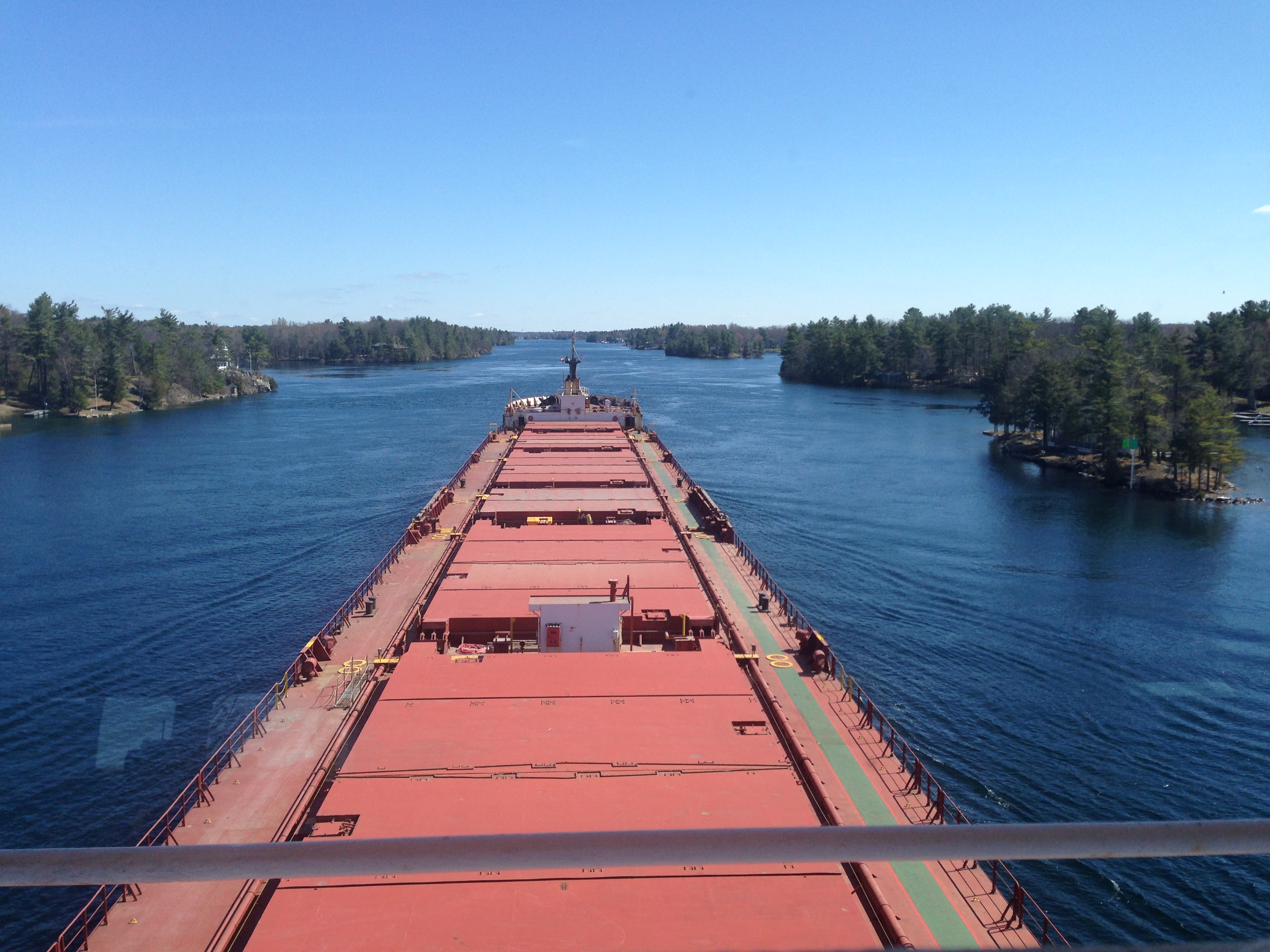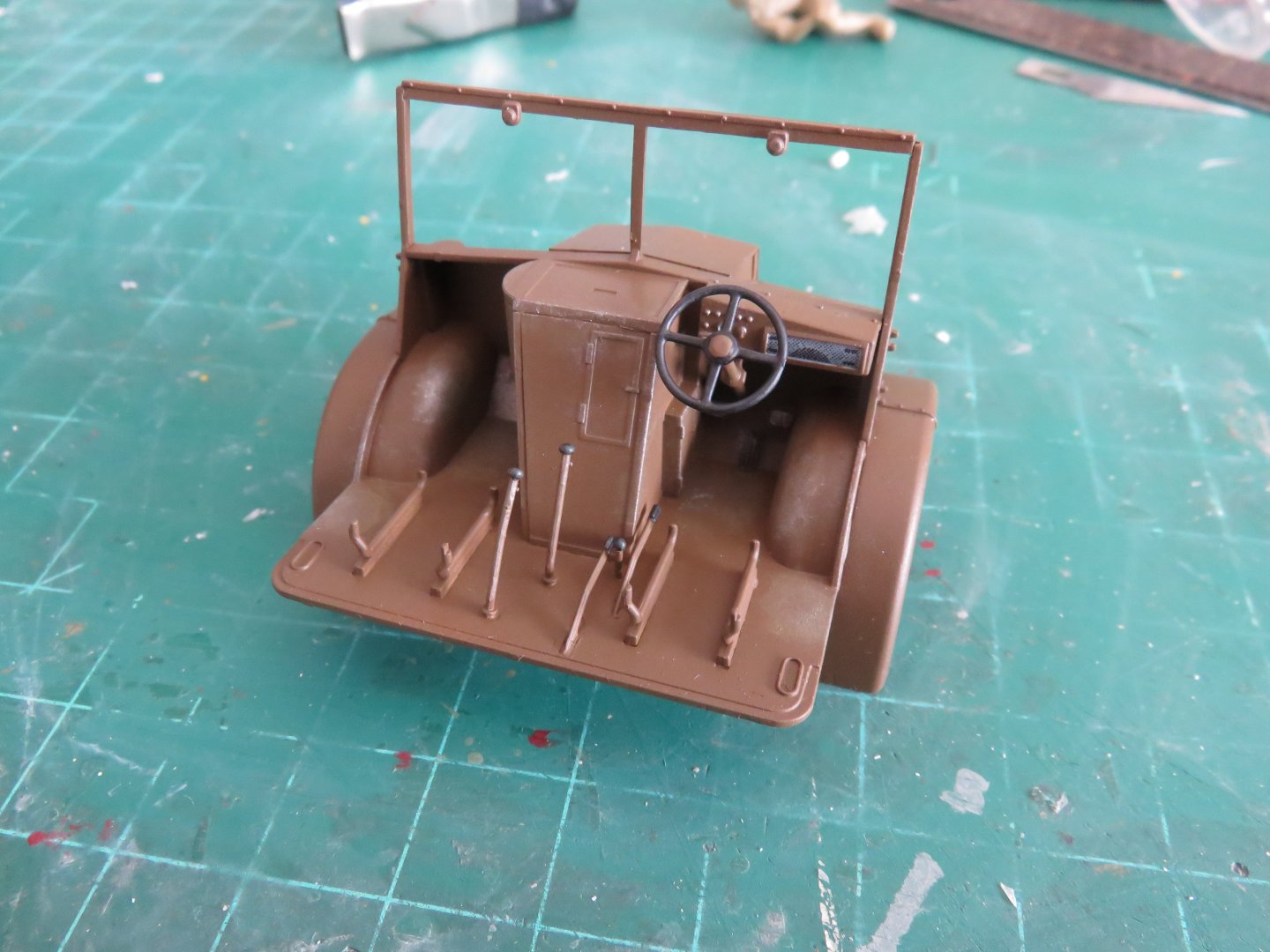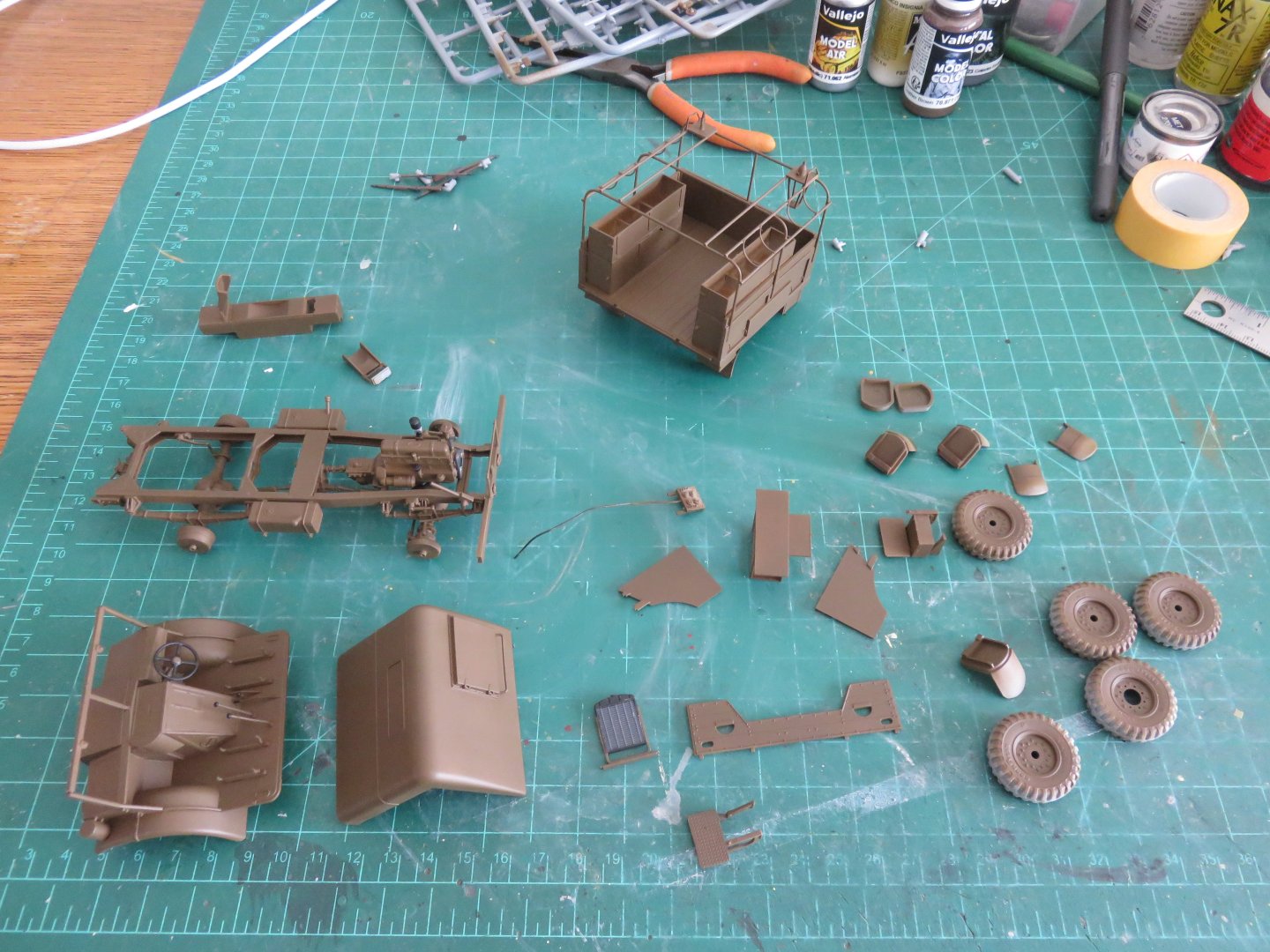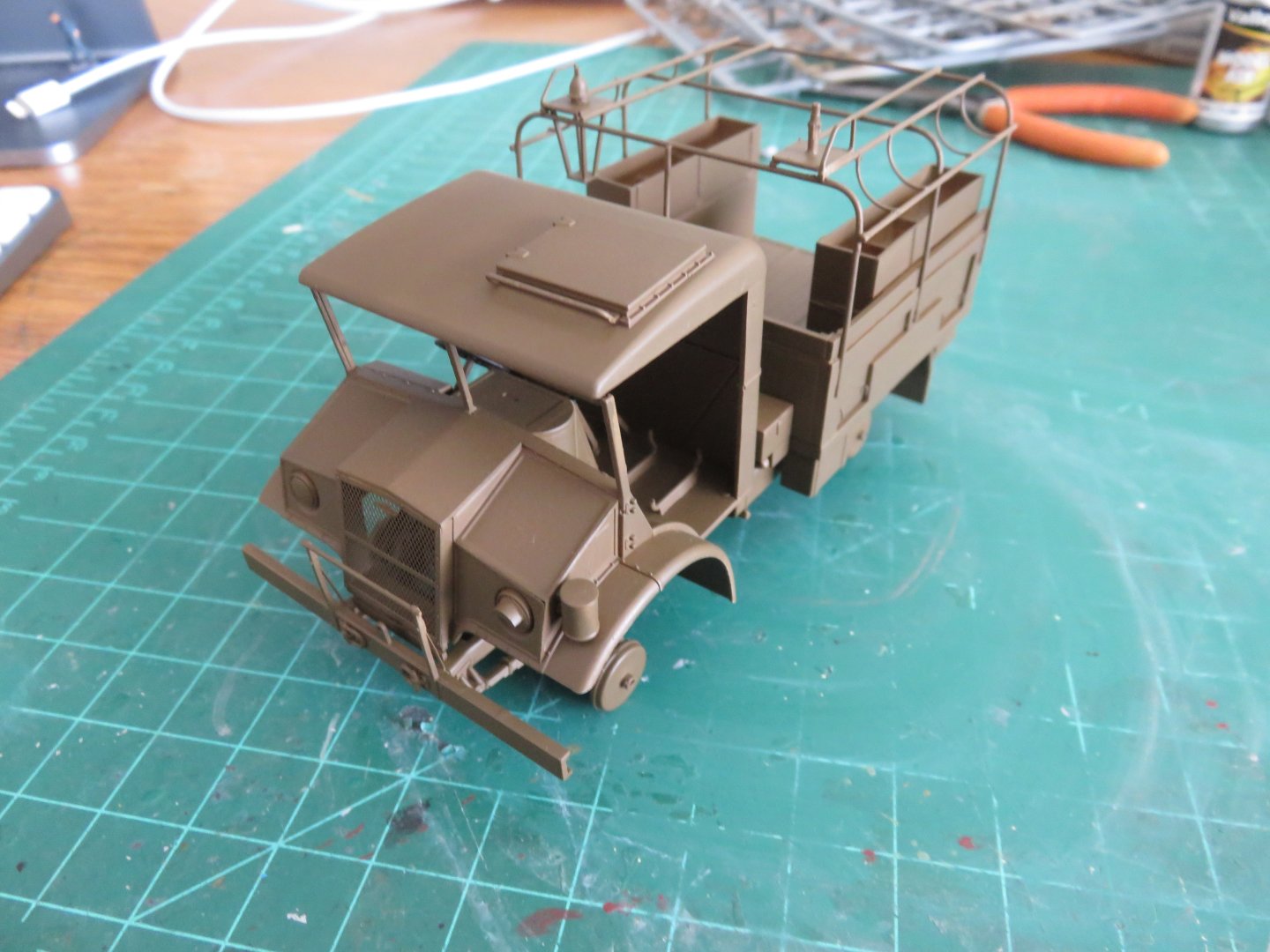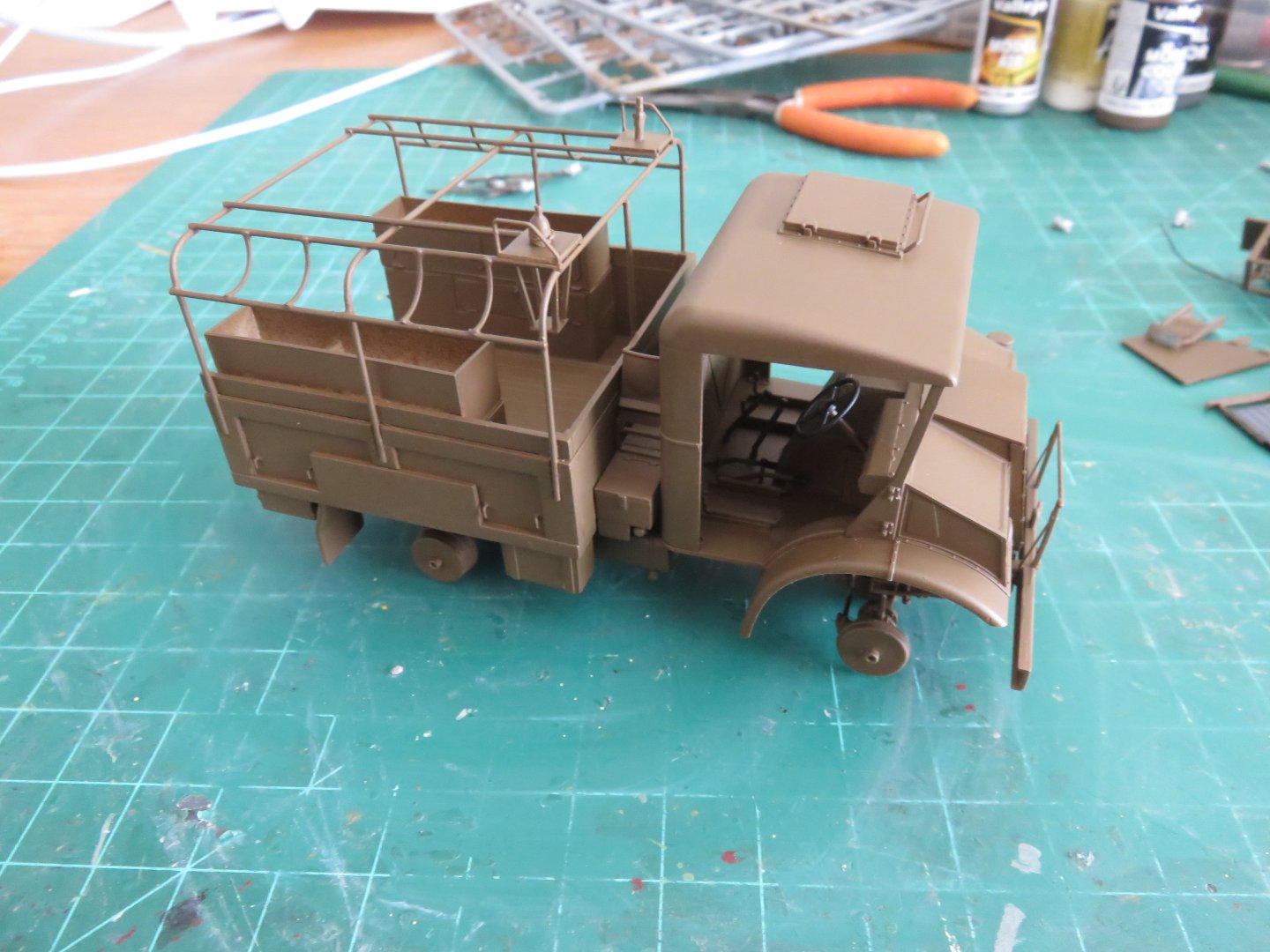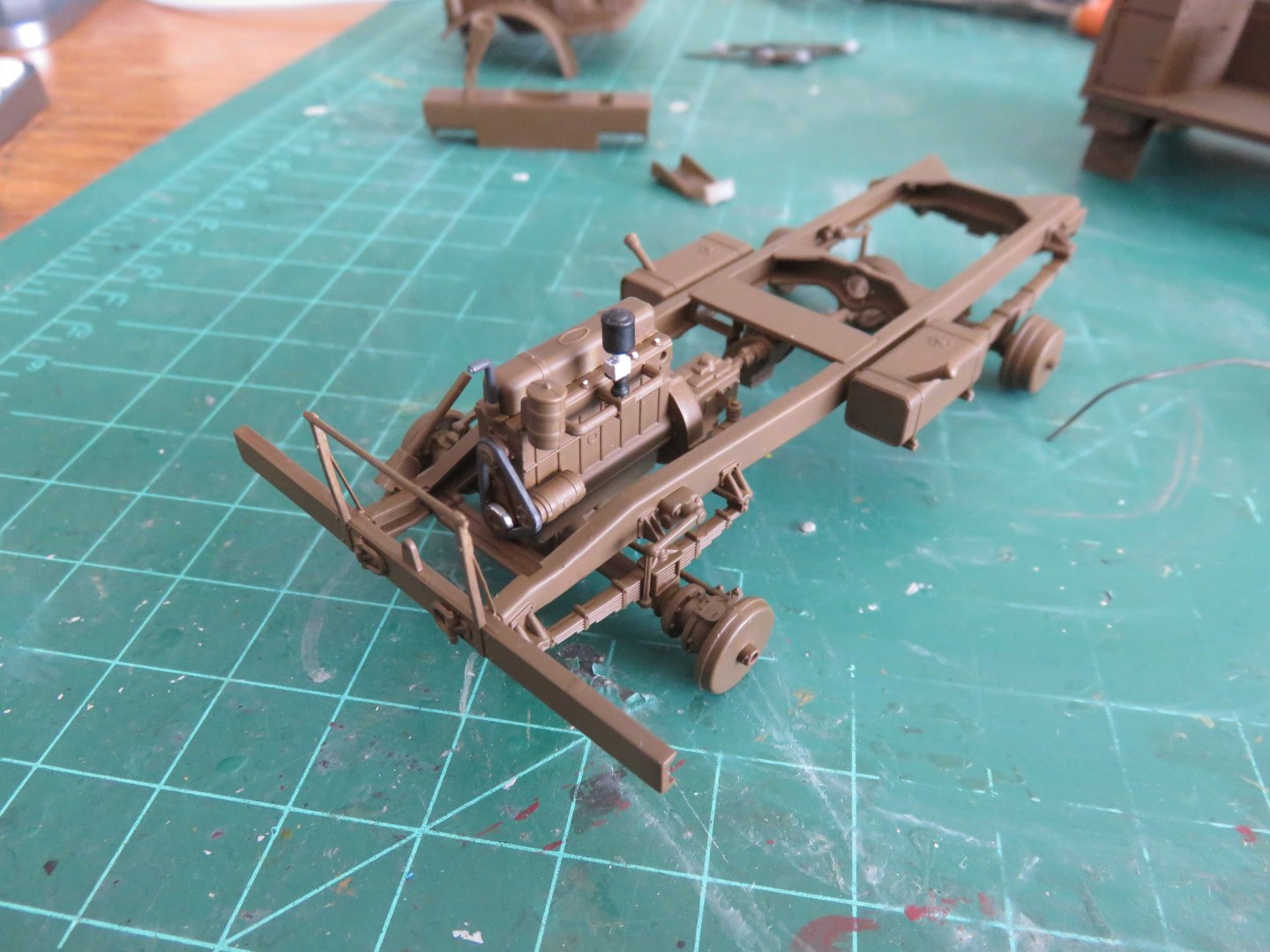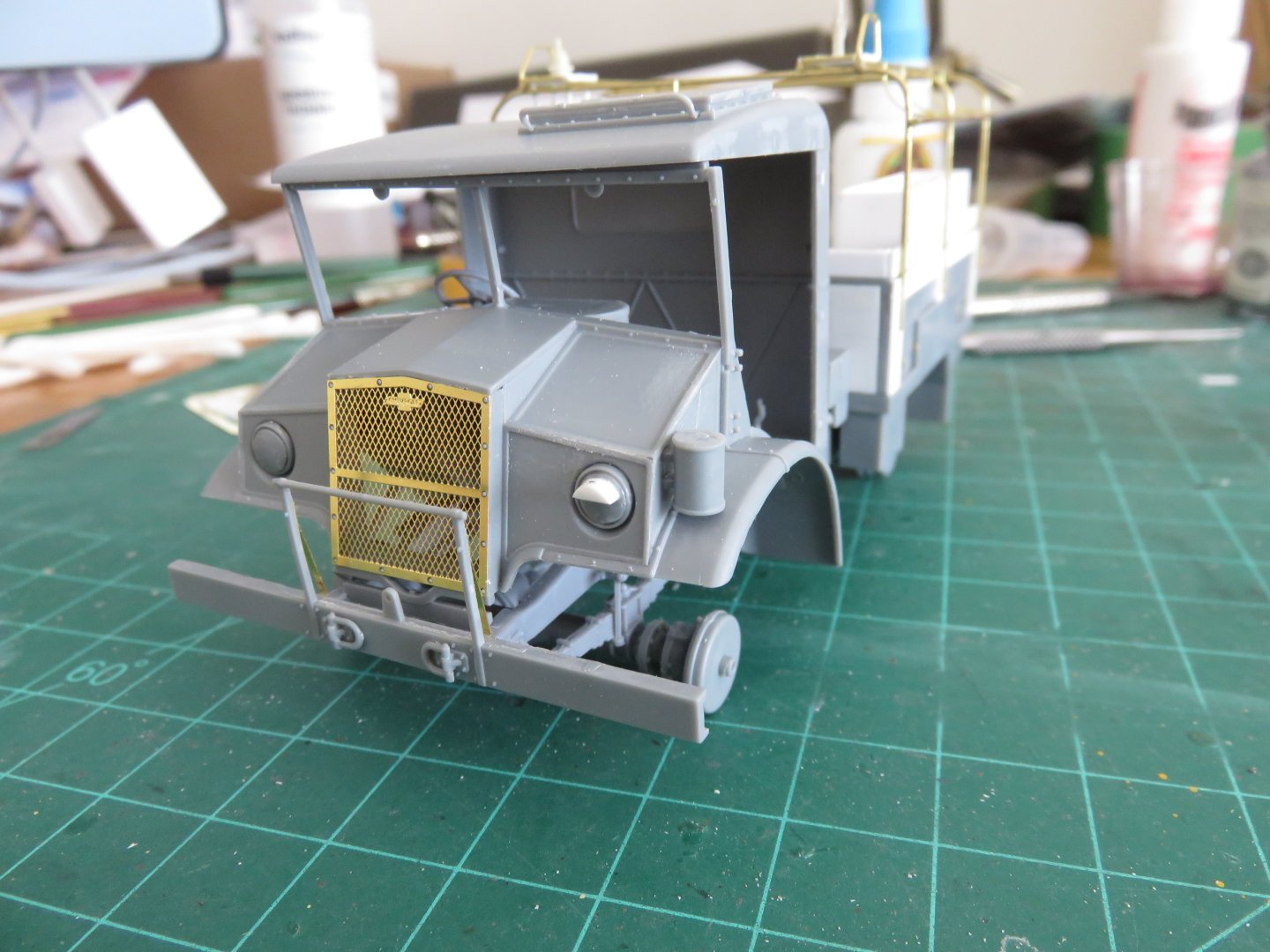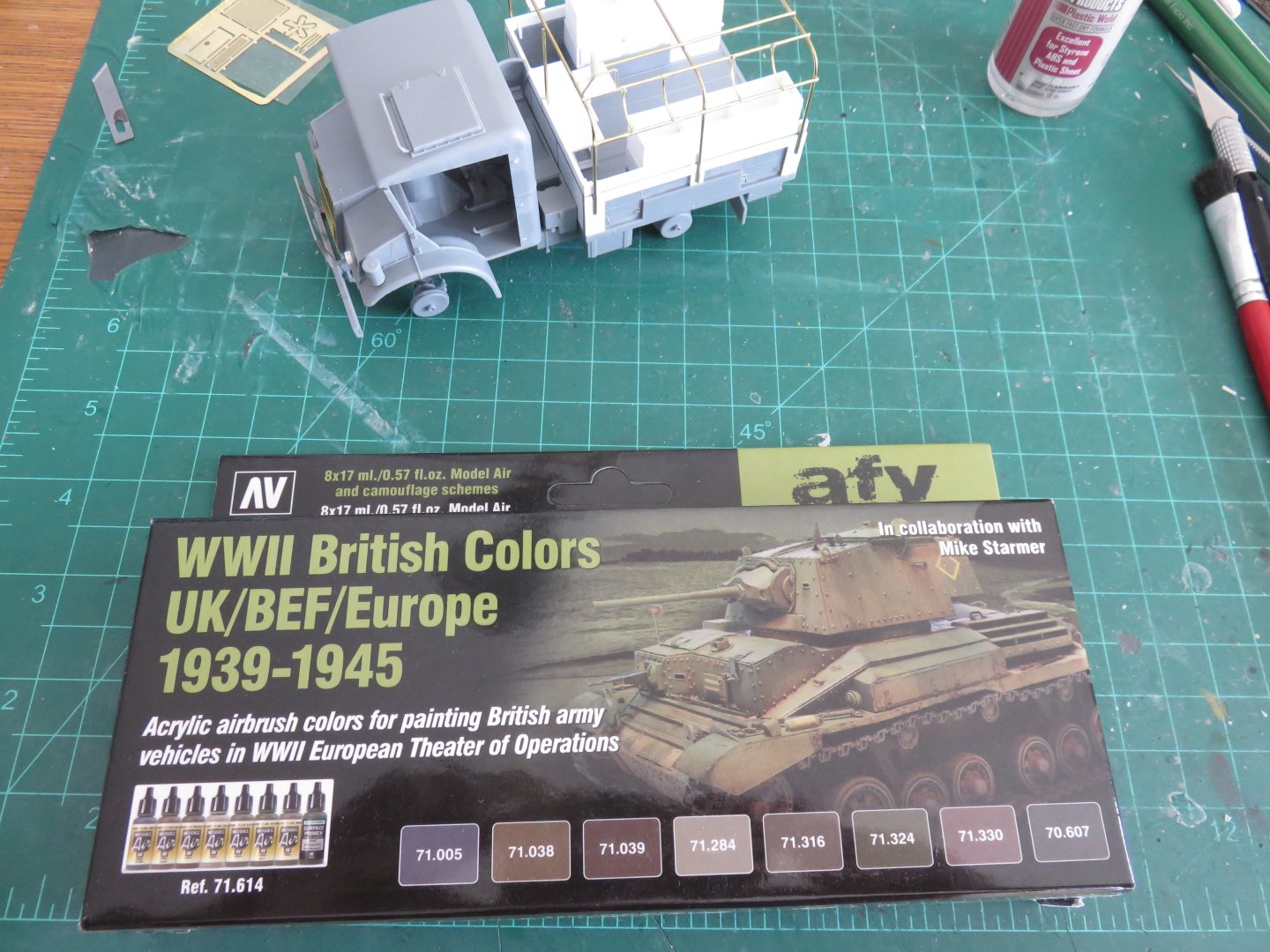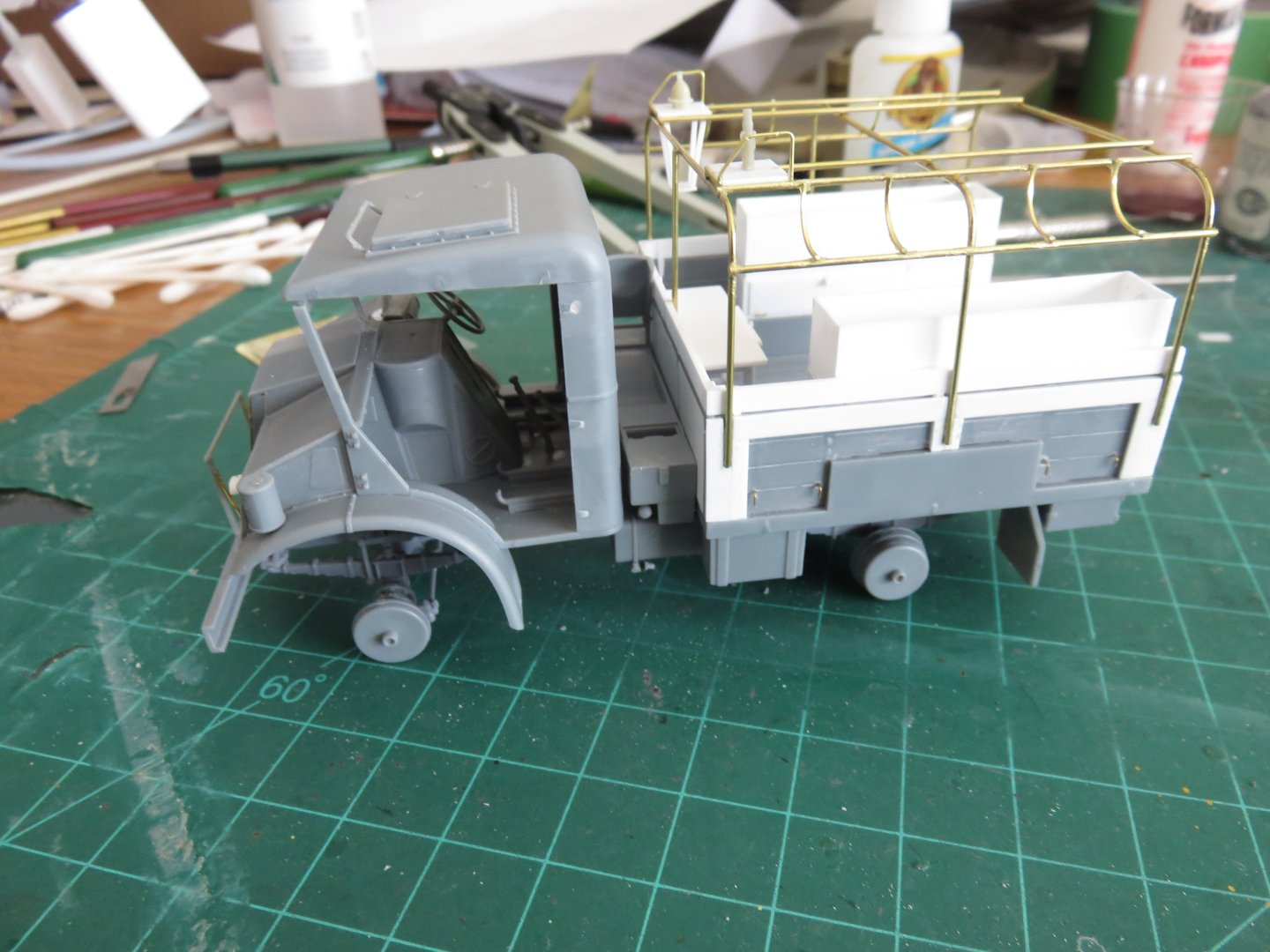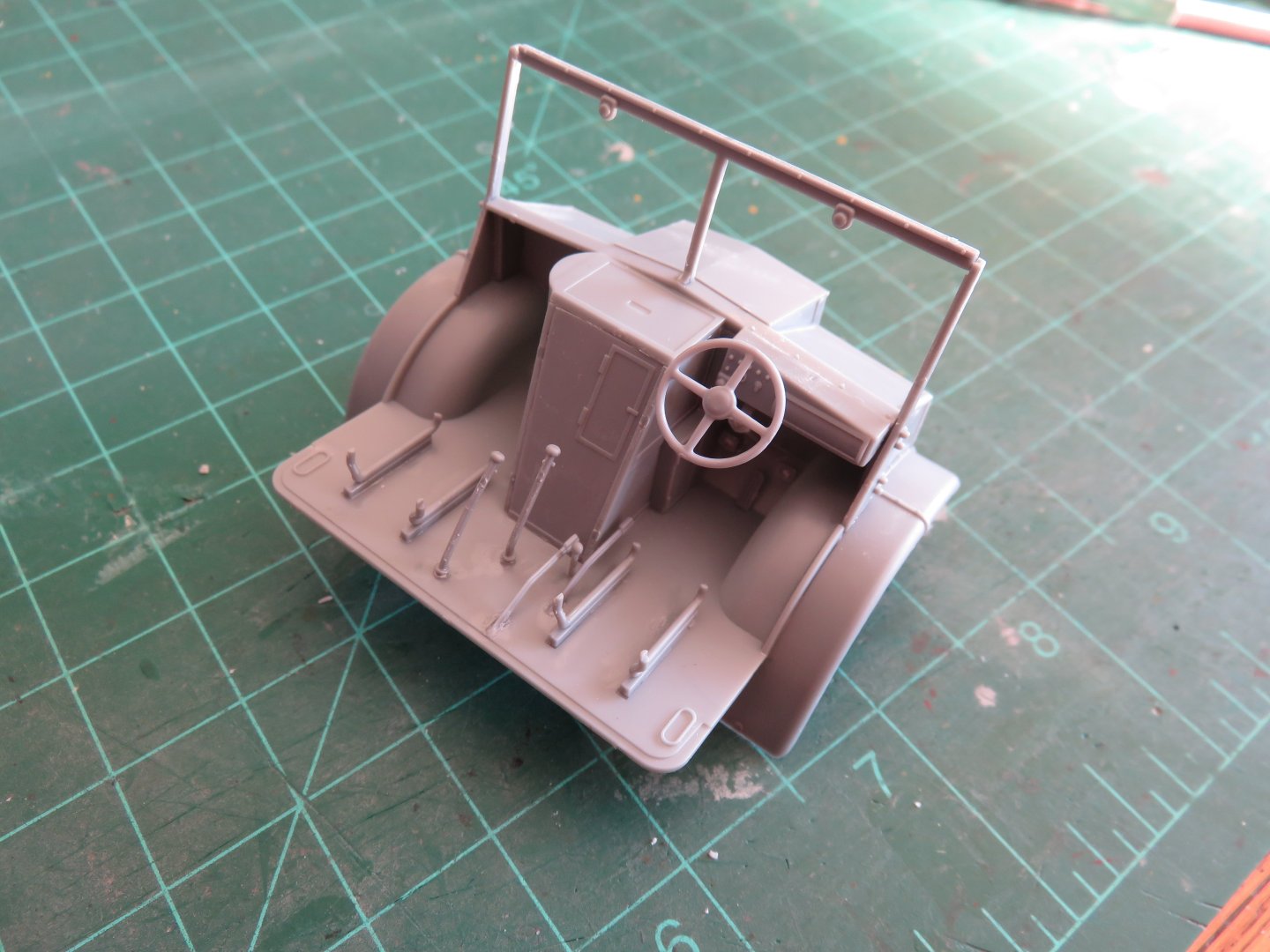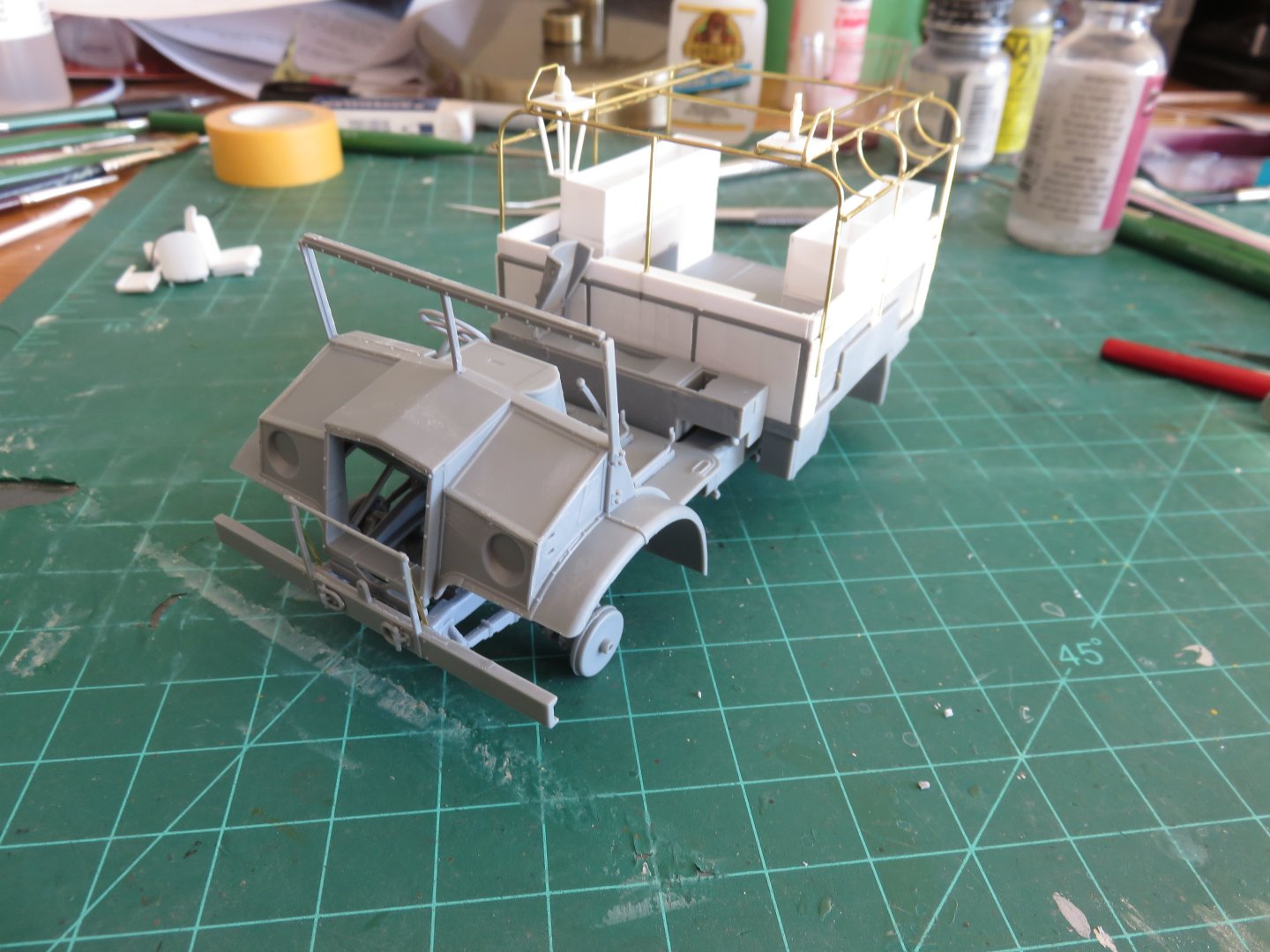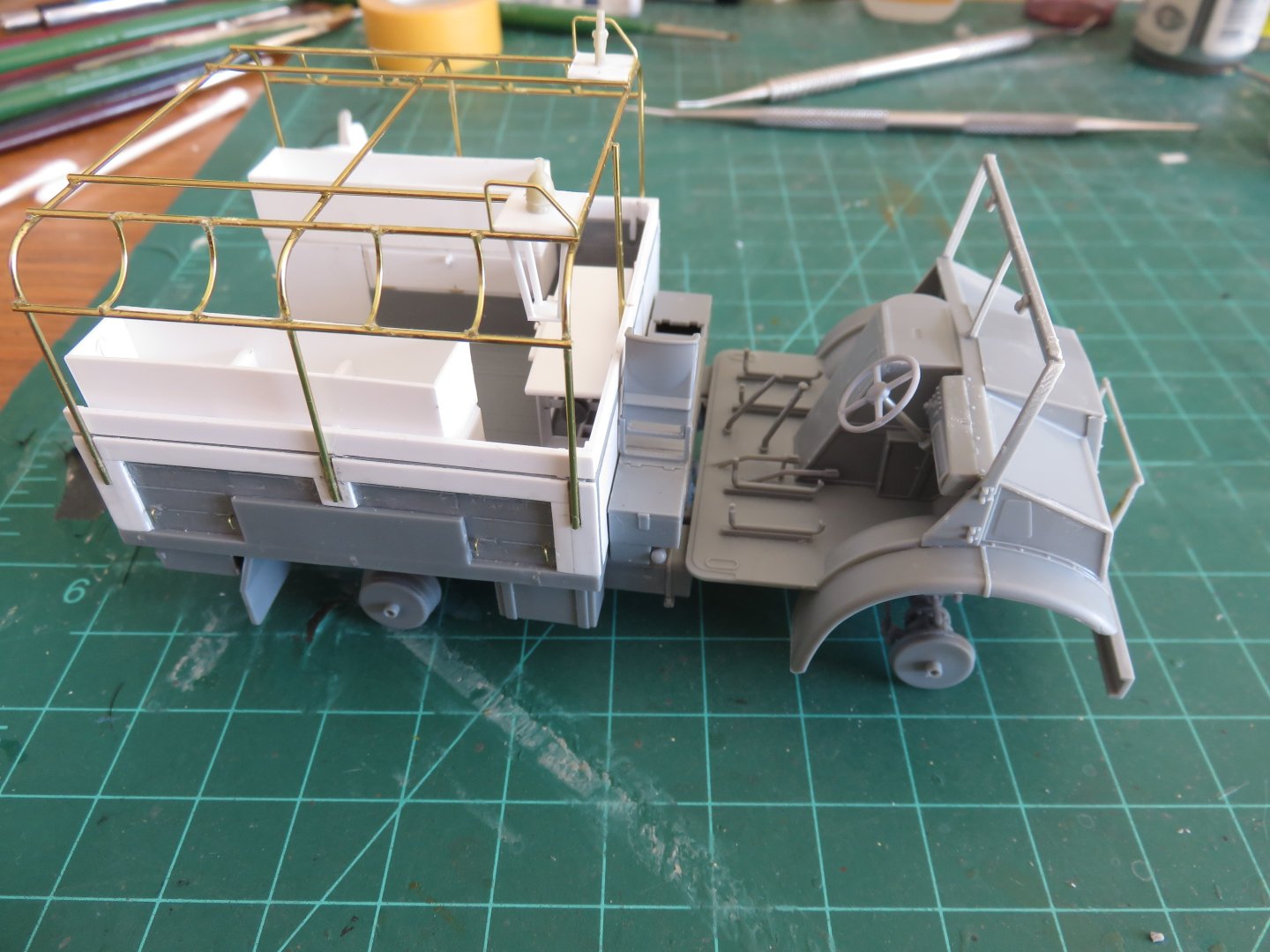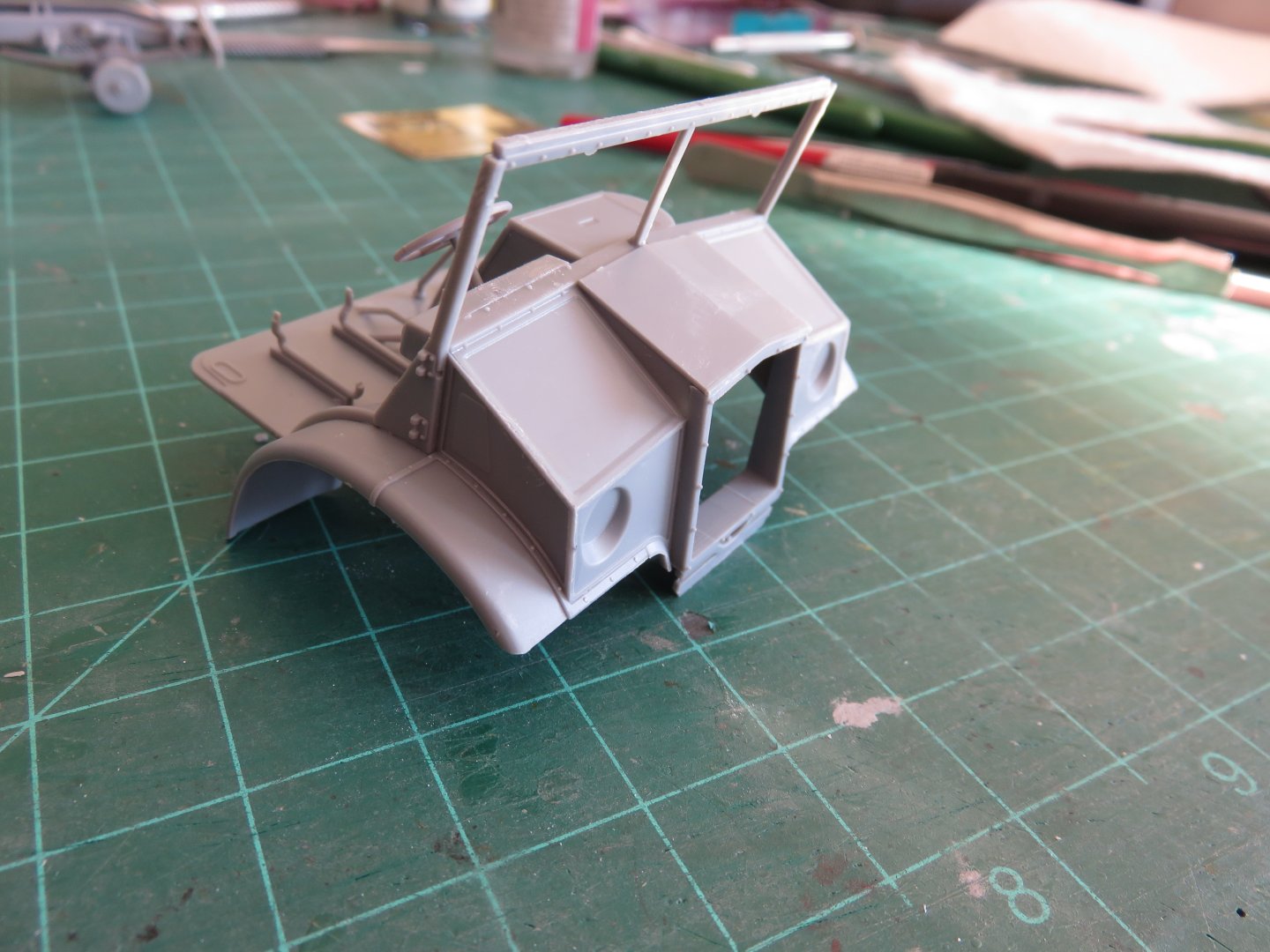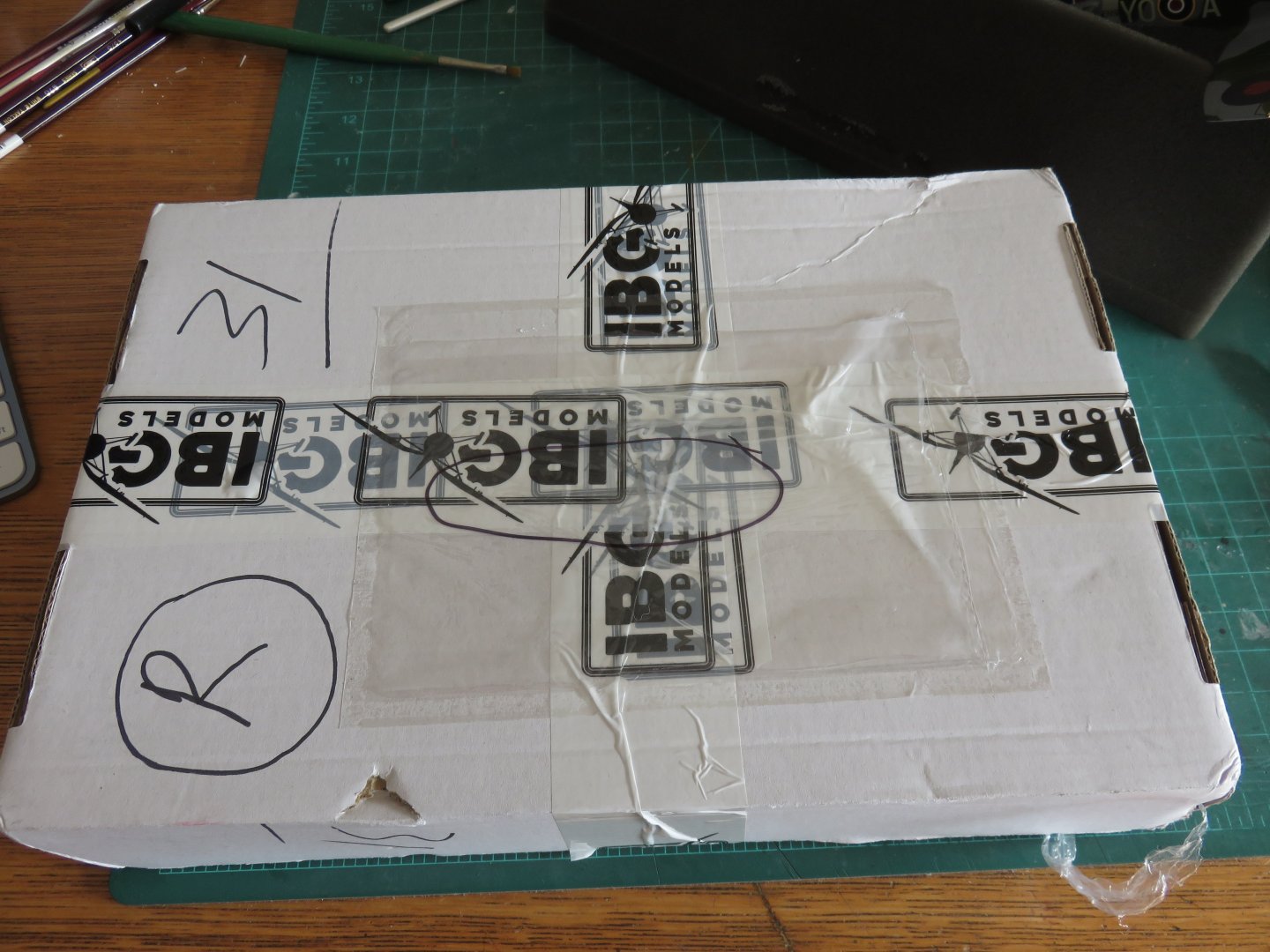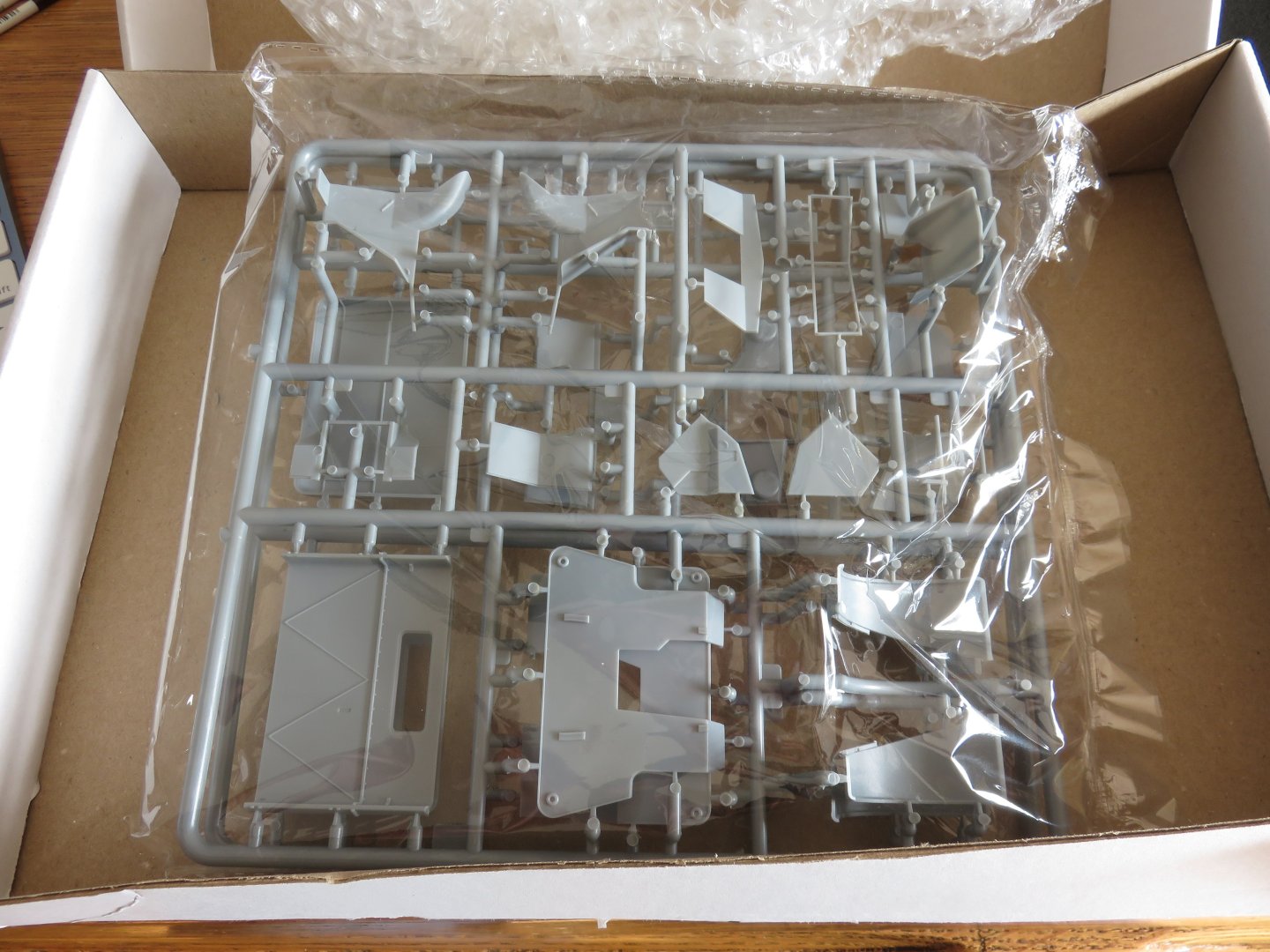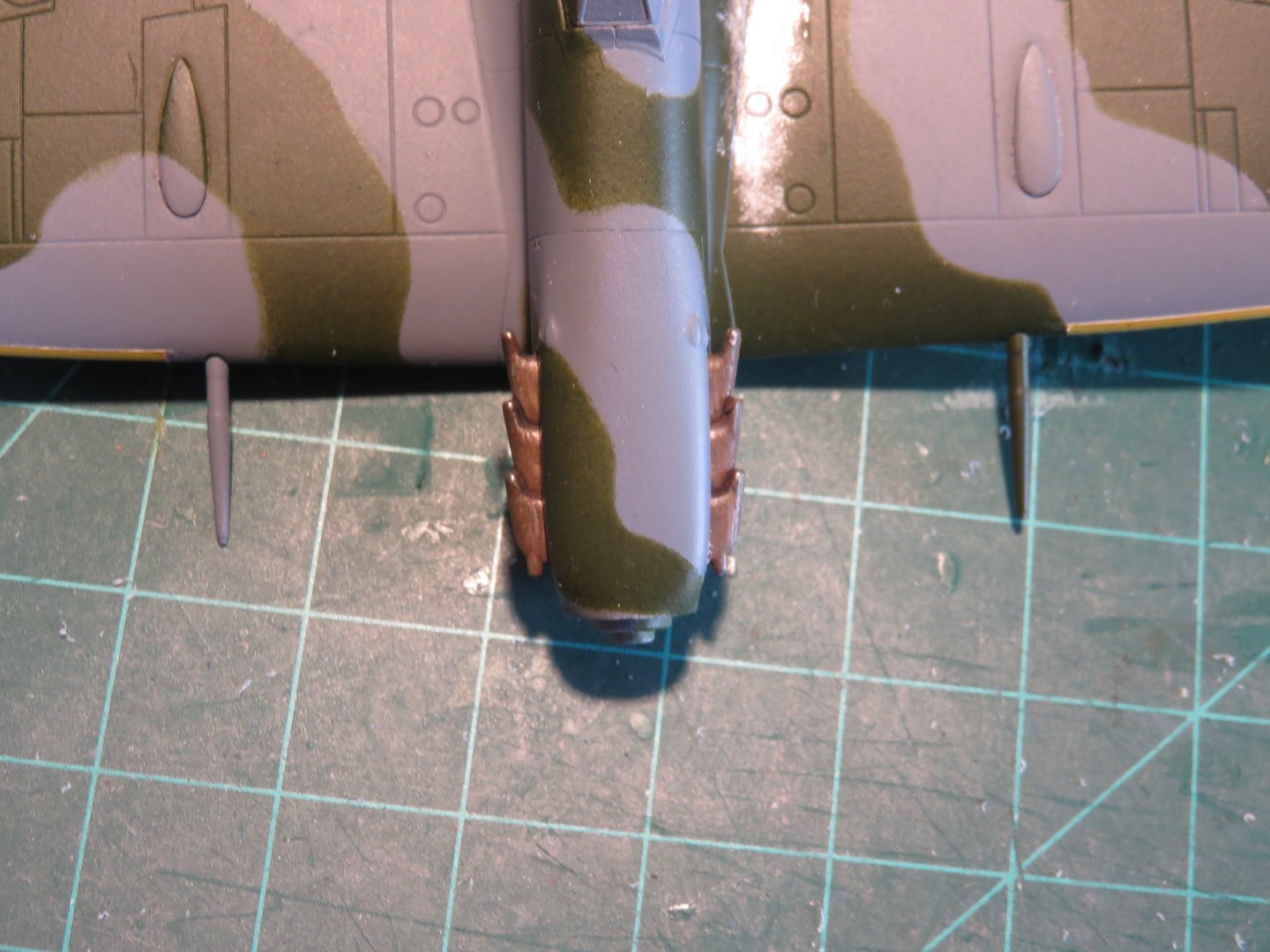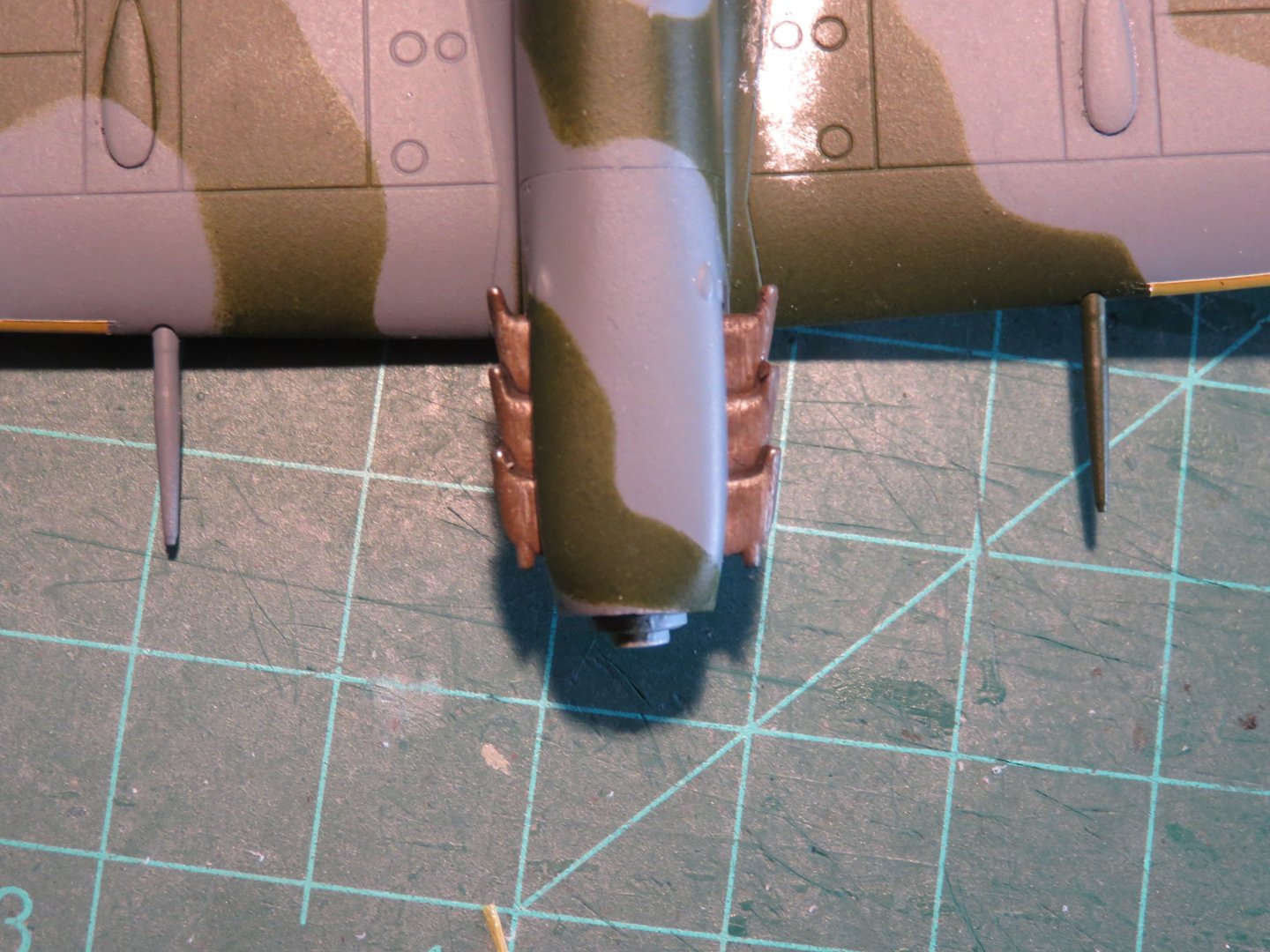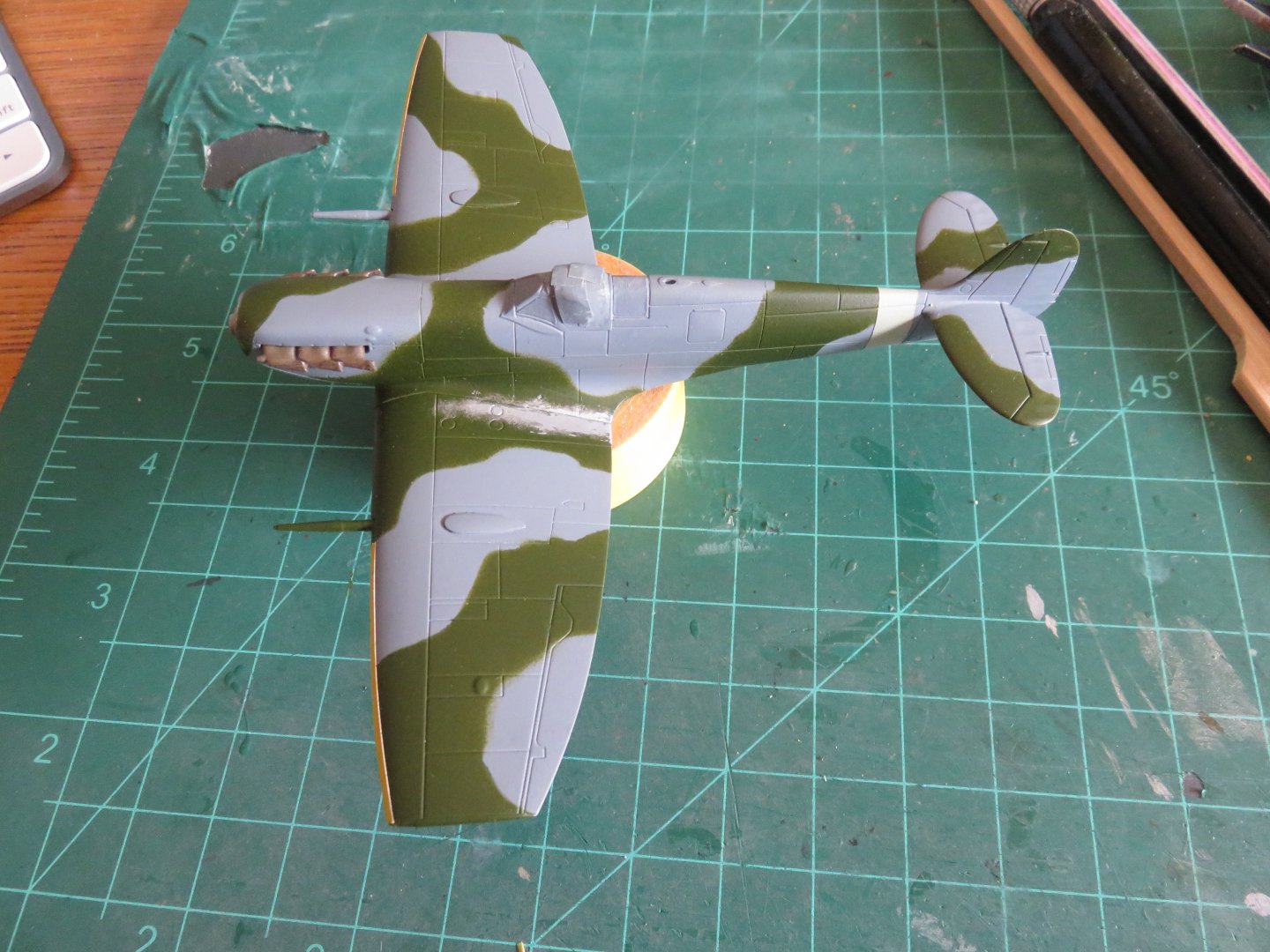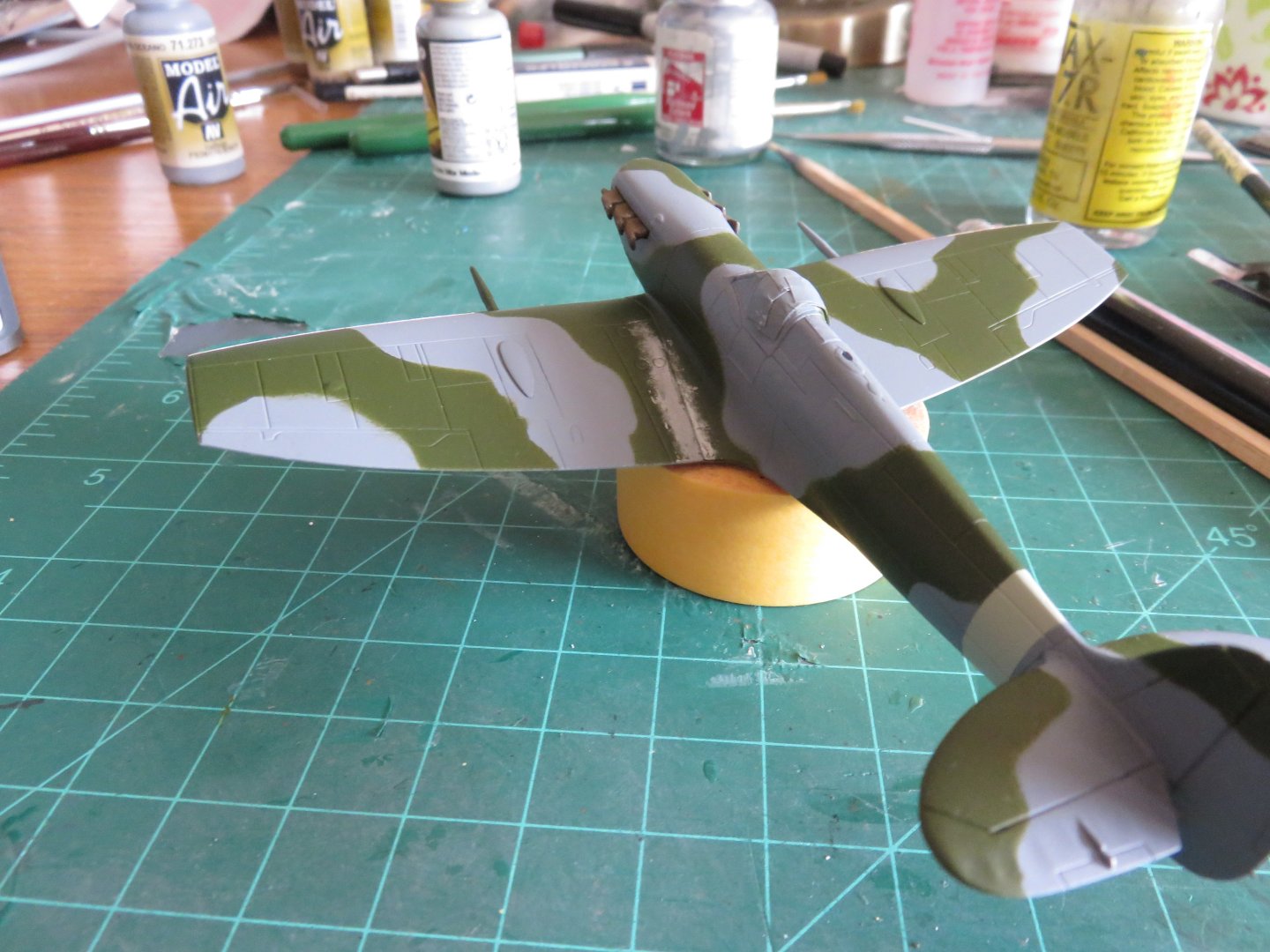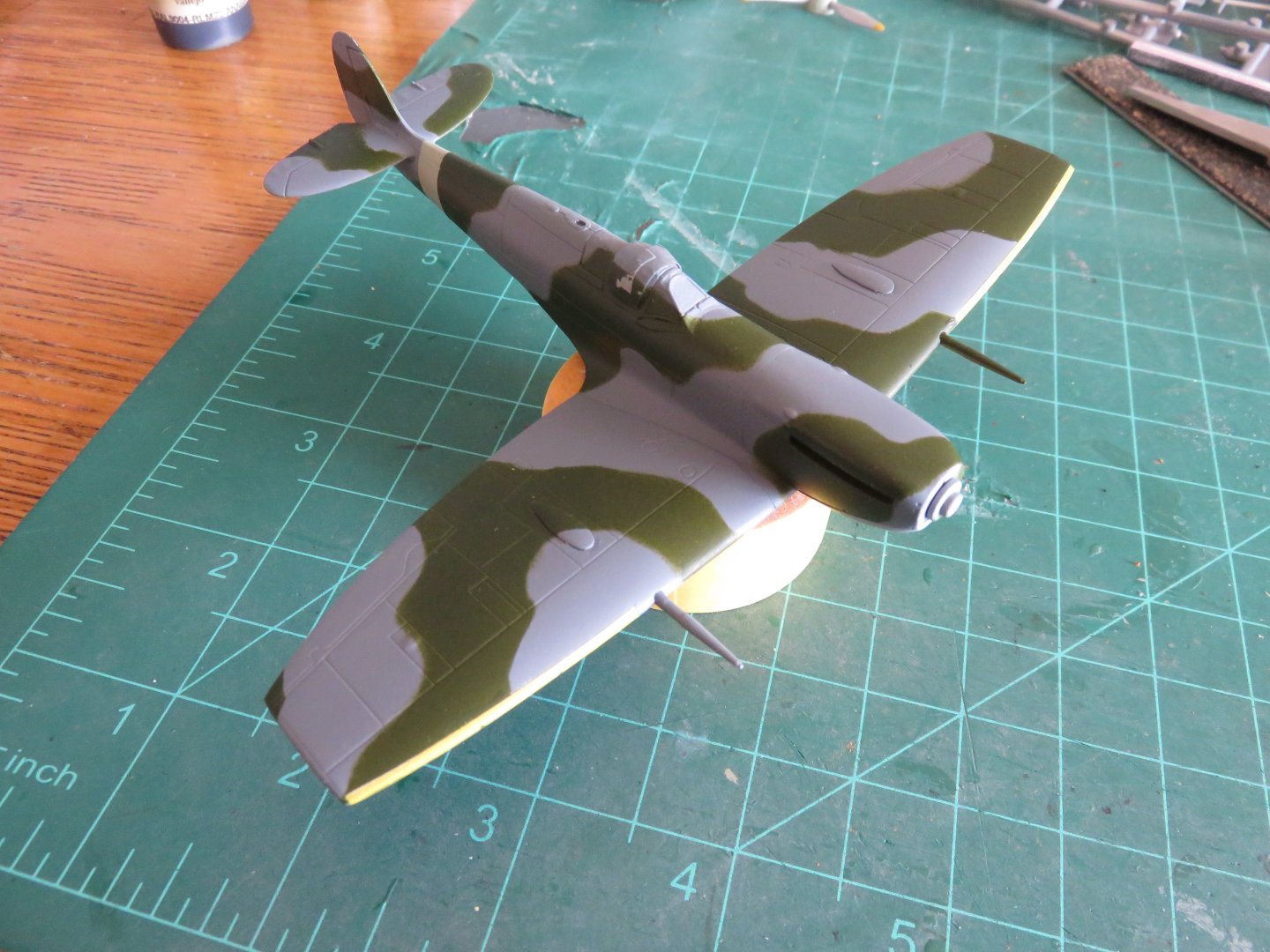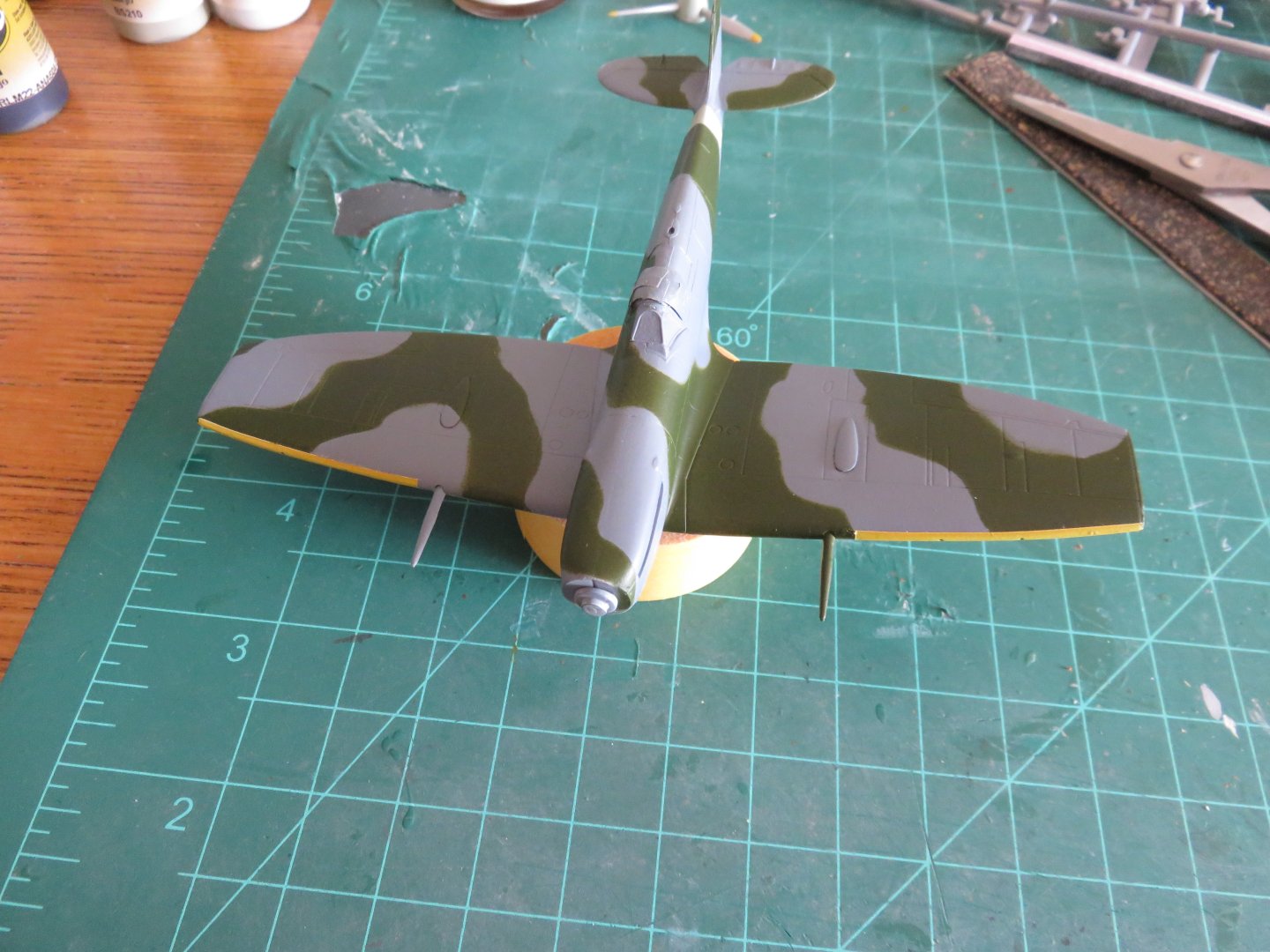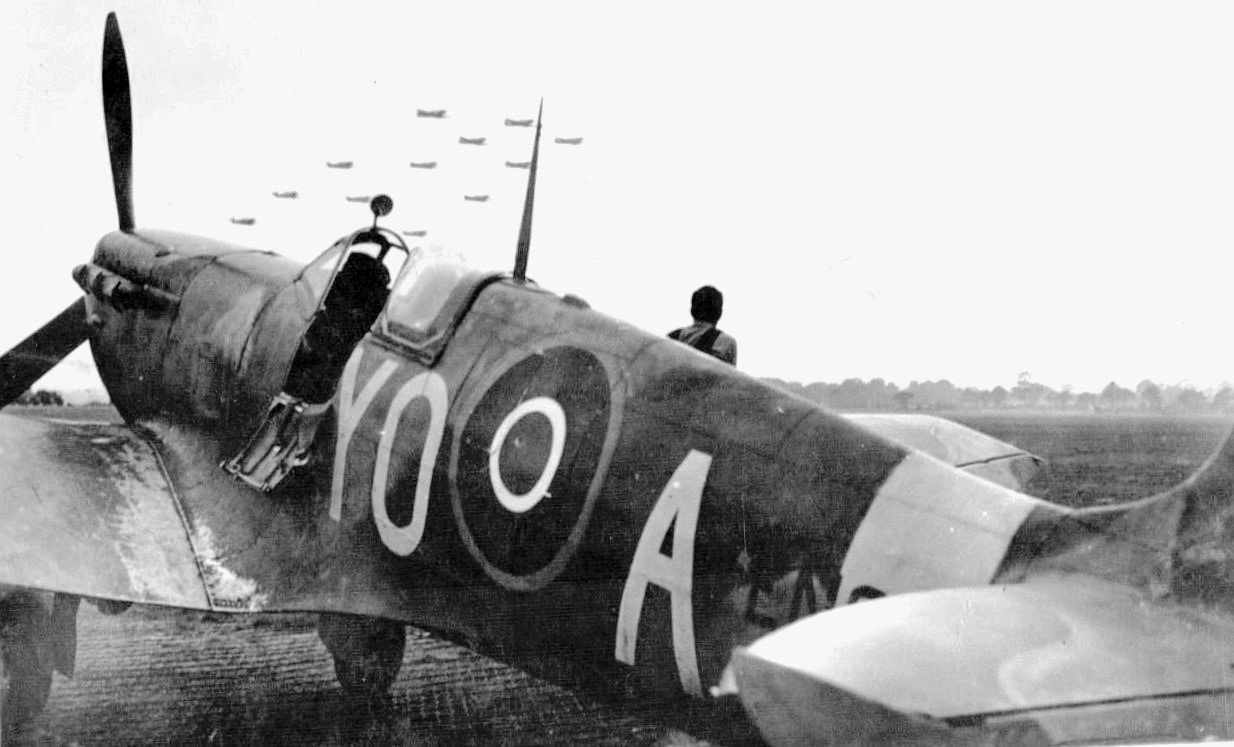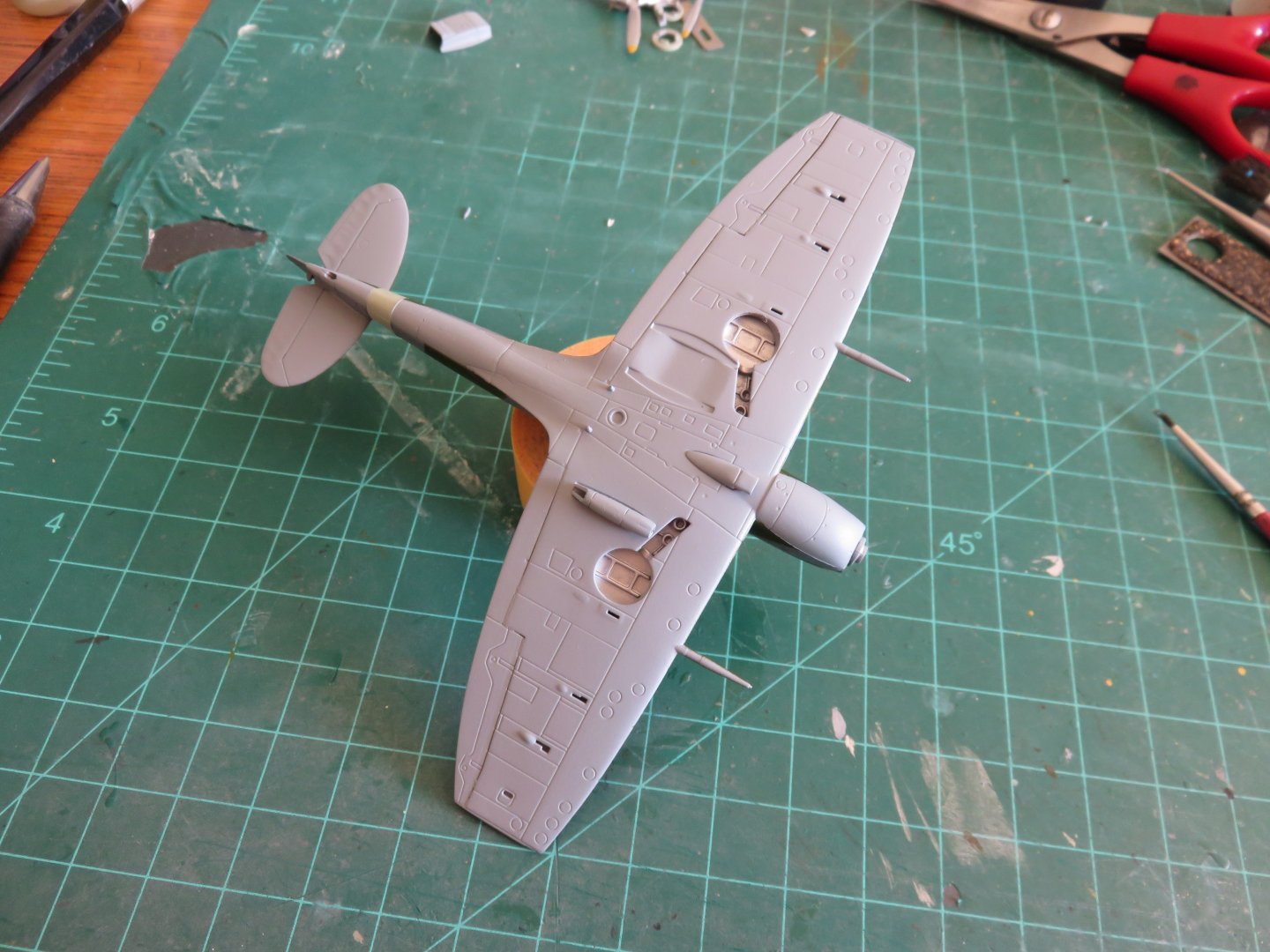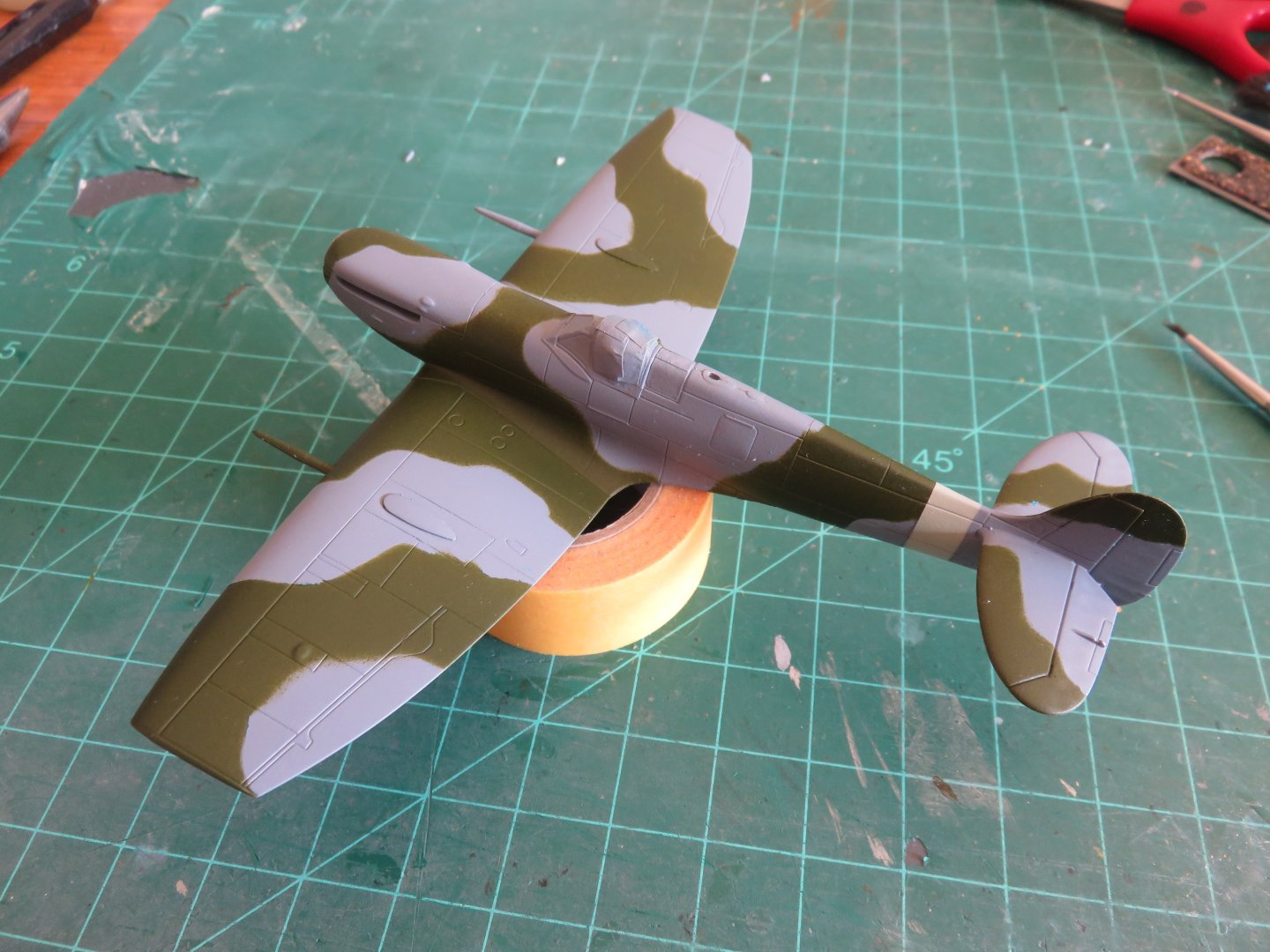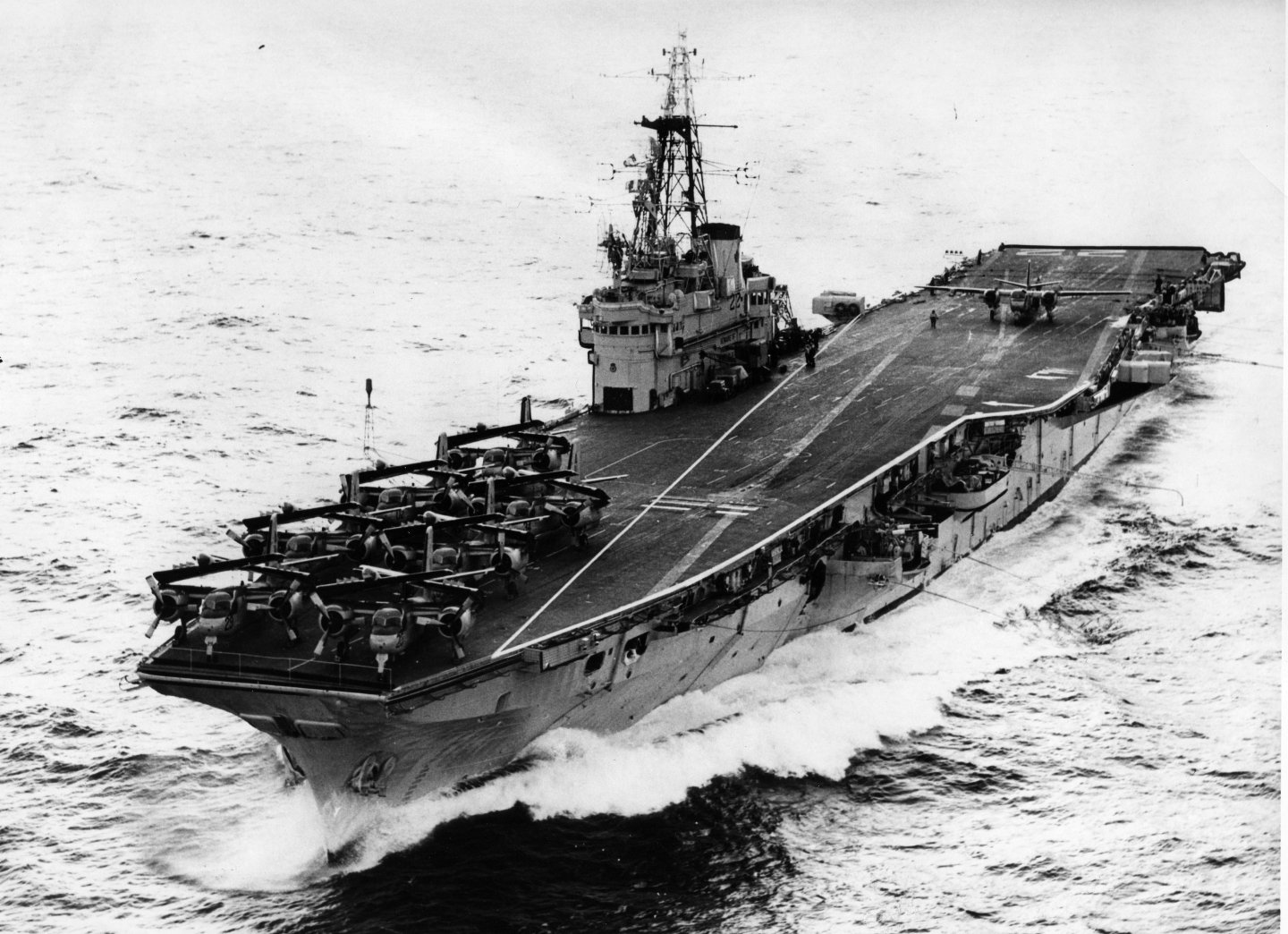-
Posts
3,262 -
Joined
-
Last visited
Content Type
Profiles
Forums
Gallery
Events
Everything posted by realworkingsailor
-
A small Saturday update. I've been picking away at some smaller parts the last few days. I've so far managed to get all the resin components of the No 19 radio set sorted out and off their casting blocks. Not much to see yet until after painting and assembly. I've also managed to sort out my dashboard! When I was researching this kit a while ago, I noticed Scalemates had an Eduard PE detail set listed as an aftermarket upgrade. Clicking on the uploaded instructions, Eduard would have you cut out a print of the dash and glue it in place. I simply downloaded the instructions, scaled the dash to the right size on white paper, then printed on some blank decal paper I had kicking around. I painted the pachgound insert with RAF Ocean Grey. In hindsight, I should have gone with a lighter shade, but this will do. At least it now looks like there's something of a speedometer in my truck! I have also begun to add a little wear and tear on the interior surfaces. I first made a mix of RAF dark earth, lightened with a drop of Khaki, thinned to a wash and dry brushed the mix onto various surfaces to represent worn, but not entirely removed paint. This was followed by dry brushing some Humbrol Gunmetal for where the paint may have worn off more completely. I will slowly build up the layers until I am fully satisfied. I plan to follow this with a dark wash to get in the deep recessed areas and bring out some of the details. Anyway, that's about it for now, thanks so much for all the "likes"! Andy
-
Well, after nearly a week, I have a brown truck.... or at least, an array of brown painted components that might assemble into something vaguely resembling a truck... I wanted to paint my truck in the early to mid war SCC2 brown, rather than the more commonly seen SCC15 OD green. I'm still debating whether to keep it solid brown or add the SCC1a dark brown disruptive pattern. British and Commonwealth vehicles used in the Italian campaign could be found in pretty much every possible British paint scheme, very often at the same time. Often the regiments were so short on time, and replacement vehicles needed so badly at the front, that (re)painting was often neglected. When the 5th Canadian Armoured Division, along with 1st Canadian Army Group Royal Artillery (which included the 2nd Medium Regiment RCA), were sent to Italy in the fall of 1943, they went without any motor transport or armour (no artillery guns, tanks, armoured cars etc). The political wheeling and dealing that brought the balance of 1st Canadian Corps to Italy (1st Canadian Division had been in Italy since Operation Husky, the invasion of Sicily), meant that the Canadians would be taking over the vehicles and guns of the British XXX Corps, who were sent back to England in exchange. This fact was kept secret from the Canadian troops (so as to not dampen moral) by telling them that their vehicles has been lost en-route (a myth helped in no small part by a Luftwaffe air raid that sank two ships and severely damaged a third while the convoy was passing Algeria). Many of the vehicles left behind by XXX Corps were no prizes, however. Many had been in service since the desert campaign, and suffered from many war weary miles. The War diary of the 2nd Medium records an eventful journey in late December 1943 by an advance party in an old Dodge D15 15 cwt truck. The truck had no doors, no brakes, the transmission was missing a gear to two, questionable tires. They had to travers a not insignificant portion of Italy's mountainous terrain in winter. How the men and the old Dodge managed to survive the journey is still unknown. Back to my C15a FFW, Some more test fitting and detail painting has also been carried out. Unfortunately the dashboard is rather lacking in details. Yes there are some buttons and switches, but there's nothing for the speedometer or other indicators that were located in the rectangular panel to the left of the steering column. I will be painting the seats and setbacks in a kind of khaki colour, and after they've been added, I can finish assembling the cab. Just for fun another dry fit of the compontents: I will also need to add a few more small details to the rear area. There were a number of brackets for hanging various small radio components, like the headsets, spare aerial mast sections and even a few rifles. I should be able to make those up fairly quickly and get them added on without too many issues. Thanks, as always, for all the "likes"! Andy
-
A quick little update for a snowy Thursday morning! A few more components have now been added to the cab: The "headlights" have been added, these consisted of an insert and the blanked lens. IBG seems to have forgotten about the blackout hood that covered the somewhat useable headlight. I made mine out of some styrene rod. Fun fact: while in England, the hooded headlight was on the left hand side of the vehicle, but a couple of days before D-Day, the headlights were swapped so the hooded light was on the right in order to account for the change of roadside the vehicles would be using when on the continent. Interestingly, this change does not appear to have been applied to vehicles operating in Italy. The PE grill fitted perfectly, no issues there. The cab back and roof are glued together, but otherwise just dry fit for now. A little bit more clean-up on the really large sprue attachment points, but otherwise it's really starting to look like a truck! It's nearly time to start getting some paint on this build! I have quite the collection of various parts that will need to be painted separately. Unlike when I build the Tamiya Ford gun tractor, which broke down into only three convenient sub assemblies (not counting wheels and tires!). A bit more planning is needed with this kit! Thanks for all the "likes" Andy
-
There is a passage in a book by Ian V. Hogg, Barrage: The Guns In Action, (Ballantyne Books, 1970), where he relates an interesting anecdote from the summer of 1940 (summarized): An acquaintance, who in the previous war, had been trained on railway guns, had been dispatched to the coast of England to reconnoiter feasible sites to deploy any of the few remaining railway guns the British army had. Examining a map, he discovered a little valley, adjacent to a main railway line. He set out with a companion to further study the ground. They were surprised when they almost tripped over some rusty old railway spur that led through their chosen valley. Following the disused line, they found it terminated in two old weatherbeaten sheds. Looking between the cracks in the boards, they could just make out some form of machinery. Having decided that this was a prime location to deploy a railway gun, they decided to investigate the machinery in the sheds further. After breaking the lock they found themselves staring at a still gleaming 9.2” railway gun, another was found in the second shed. Alerted to their presence by a suspicious shepherd, the police showed up, along with an elderly pensioner, who happened to be the caretaker of the two railway guns. He had been tending them since they where parked there in 1918, and they were fully serviceable. He had been paid, via the local post office to keep them cleaned and greased and “Bless me, sir, d’you tell me as you didn’t know they was there?” Andy
-
So, it has been nearly a month since I did anything constructive on this build! Waiting for parts.... waiting and waiting.... and waiting..... Well, time to get going again! One thing to note, the IBG kits are definitely not for beginners. There is a very high part count for each step, and the parts are small, fiddly, and need precise cleanup and fitting, or things can go wrong very quickly. The cab assembly I've made up to this point has involved no less than 27 parts (even after leaving a few off to make painting easier)! A good couple of hours work and the familiar pug-nosed profile of the No. 13 cab begins to take shape. So far, I have left off the seats (4 parts), mirrors (four more parts) and fire extinguisher (one part). The grill is PE and I will add that next, followed by the headlights (well, what was left of the headlights after the blackout masking was applied). A word of caution, even though the seat bases are all the same part number, they are mirrored left and right for each seat to accommodate the supports for the seat backs. The rear supports should flare outwards to pass around the seat cushions. For whatever reason, IBG did't give different part numbers. After all the work, I couldn't resist a little dry fitting to see how things look when all the major components I've built so far is brought together: Finally, it's starting to look like a truck! Thanks for all your patience! Hopefully there will be no further parts related delays! Andy
-
Thanks for all the kind comments and "likes" everyone! I think I'm ready to call this one done! After sealing everything in, I applied a little bit of a wash in some of the panel lines and recessed areas. I then dry brushed on some aluminium colour to add a few more signs of worn paint, especially around the starboard wing root and canopy areas. Finally I did my usual soot and heat staining using pastels applied with a brush and blended. For this plane, I had to go easy on the engine exhaust. From the prototype photos, the lovely lady was reasonably clean, and likely kept that way by the ground crews. Yes, I decided to add the figure in the cockpit. Even had I left the canopy open, there really wouldn't have been much to see, so with the canopy closed, there's a sign of "life". Spitfire EN921 was assigned to 401 Squadron, RCAF, between July and October of 1943. During its time, it wore the code YO-A and was flown by F/O Jack Sheppard. Over the course of the war, he scored 5 confirmed "kills", all FW-190s. The wear on the starboard wing would not have been as heavy as the port side, but there's photos of the ground crew standing there, so some foot traffic should be evident! Overall, this has been an enjoyable, and short little build. As a fairly recent Airfix product, there is an abundance of detail for a 1/72nd scale kit. I encountered no major fit issues beyond what one would reasonably expect for a plastic model. I wouldn't hesitate to recommend this kit to anyone who's interested. A word of note, however; the Kitsworld decal set that I used for the code letters and the nose art appears to be printed, rather than silk screen printed. This means that if you examine the decals closely, there is a grainy-ness to the colours. It's not noticeable from any normal viewing distance, and the decals are still very high quality. Thanks again to everyone who has stopped by and offered their likes and comments (and thanks to those who have simply stopped by)! Looks like I will be returning to my Chevrolet C15a build very soon, see you all there! Andy
-

"Wind of the ball" injuries.
realworkingsailor replied to uss frolick's topic in Nautical/Naval History
Two different things, really; turbulence and pressure waves. Turbulence is the disruption of air as a result of something passing through it. The air can move dramatically in different directions. Yes it can be violent, even modern jets need to be careful of wake turbulence when operating near one another. In your example the asymmetrical action of the turbulence, and the resulting aerodynamic forces acting on a relatively fragile airframe exceeded its structural strength. I very much doubt that the pilot was killed by the turbulence, or even the blast concussion from the fired gun (had he been foolish enough to be flying that close), more likely the abrupt stop when he unexpectedly returned to sea level sans aeroplane. Have a look at the research done by John Stapp in the 40s and 50s (he’s the guy who rode the rocket sled “al fresco”): https://en.wikipedia.org/wiki/John_Stapp Andy -

"Wind of the ball" injuries.
realworkingsailor replied to uss frolick's topic in Nautical/Naval History
I think you can take modern equivalents into account as well. How many WW1, WW2, or even Vietnam war stories involve bullets whizzing by perilously close (and in some cases dinging off) helmets. Or dud artillery shells landing between soldiers’ feet (lots of those stories). All resulting in minimal to no injuries at all (maybe a strong need to change one’s pants). Andy -
After yesterday's excitement of finally receiving the parts I need to continue with my C15 build, I figured it is now a good time to update my progress on here. Decals are now finished, including a plethora of stencils. Admittedly, I didn't include some of the smallest ones, as they tend to look more like specs of dirt than anything. As you can see, I have also added the propellor. (I just had to get the spinny whirly turny bit on!) EN921 had some... uhh..... racy nose art. Maybe a strategy to distract German pilots?? Underneath is grey...... very grey... Next up will be the landing gear, pitot tube and aerial mast, then weathering and finishing touches. Looks like the end is in sight for this one! Thanks, as always, for all the "likes" Andy
-
So, something arrived in the mail this afternoon.... it was a larger box than I expected... I mean.... I was only interested in a replacement part..... But IBG sent me two the whole frames that include parts for both cab variants.... wow! And the replacement part I need is in perfect condition! This is so generous of IBG Models! Excellent product support, the only thing needed is a little patience for things to work their way out of Poland. Fantastic! Looks like as soon as I'm done with my Spitfire build, I will be picking up this one again, right where I left off! Andy
-
I did a quick google search, it’s possibly the Seagnat decoy system launchers: https://www.alamy.com/stock-photo-sea-gnat-control-decoy-system-royal-navy-type-23-frigate-28795181.html Andy
-
Thanks @JKC27! It would be great to see your Spitfire build(s) here (if you feel up to it)! So my experiment seems to have worked! I think that looks fairly good as a worn walkway. Admittedly, it looks a little stark, given the lack of weathering on the rest of the airplane, but that will be fixed in time. After I had put down a layer of primer, I hit the wing root area(s) with a shot of Tamiya aluminium from a rattle can. I was counting on the Tamiya paint drying to its usual relatively hard finish. The Vallejo acrylics dry (initially) very soft, so I gently started scraping away the acrylic paint with a bamboo skewer to expose the Tamiya paint underneath. I initially smoothed the edges out with some ultra fine grit sandpaper, following that I dry brushed on some Floquil aged silver (a very close match for the Tamiya Aluminium) so further soften and blend the edges. This all has to be done before I overcoat the whole plane with Testors' Glosscoat, as the enamel will make it too hard to scratch anything off easily. The reason I used this technique is that I don't have any chipping fluid or other substitute in my stash, and I had seen this used to good effect by Youtube modeller Plasmo. This morning I turned my attention to the exhaust pipes. If there's one thing that looks off about this kit, I would say that this these are it. Looking at the plethora of prototype photos, the Airfix exhaust pipes stick out way too far.... almost like a set of canards. They really ruin the lines of the airplane. You can see above how far they stick out! Luckily the fix is fairly simple, and some careful work with an aggressive file had my exhaust pipes looking mush better! On the right, in the above photo is the unmodified part, quite a difference when compared to the treated pipes on the left! Both sets of pipes have now been given the same treatment, and I think things are looking much improved! Up next will be some final paint touch-ups (kind of an ongoing thing), then a layer of gloss and decals. Thanks for the kind comments and likes, as always they are very much appreciated! Andy
-
A small update to add for this week. The wing leading edge yellow stripes have been successfully painted on: Once they have had a good few days to cure, I have to do something that may defy all logic! (RAF Photo UK5800l), borrowed from the following web page: https://www.silverhawkauthor.com/post/canadian-warplanes-3-supermarine-spitfires-flown-by-the-rcaf-overseas-during-the-second-world-war-on-loan-from-the-raf Going by the above prototype photo of EN921, the paint on the wing root walkway area was pretty heavily worn. This plane saw a lot of use while with 401 Squadron. I have planned ahead for this scenario, hopefully things work the way I want them to! Details, and photos will follow whether I succeed or fail! Thanks for the kind comments and all the "likes"! Andy
-
Well, it's been a short while, but I have not been idle! A major chunk of the painting has now been completed! Yay! Nothing too fancy, just the typical mid-war RAF fighter scheme! The disruptive pattern on the Spitfire I'm intending to replicate (EN921) looked a little different when compared to the usual pattern's I've seen before. I did my best to follow the very few photos available online, plus I referenced diagrams from another decal set that seemed to agree with those same photos. Most other models I've seen built of this aircraft followed the more conventional RAF pattern, but EN921 had something odd going on around the cockpit. I guess the guys in the maintenance unit were bored with the same old same old! Back to the Airfix kit, I eschewed the use of the supplied decal sky type "S" coloured band around the tail in favour of paint. I did this a couple years ago on a Typhoon and it produces a much better result. After a few touch ups, and once the paint has had a good chance to cure hard (Vallejo acrylics seem to take their sweet time to fully cure, until then the paint can be frustratingly soft.... ask me how I know....), there remains only to apply the yellow leading edge stripes on the wings. Thanks, as always for the comments and "likes"! Andy
-
What about something like this: Make one bottom hull that contains all the machinery and RC equipment. At the waterline, jog the outer “shell” inwards to allow an interchangeable upper hull to nest over top. Carrying the overlapped up to the deck line should mean that any water issues would be no different than any other RC ship. Then make two different tops, one aircraft carrier, one tanker. Andy
-
Thanks for the likes and kind comments! Having built this kit once before, work has proceeded reasonably quickly, only the wing mods are "new" territory. As I mentioned earlier, I was satisfied with my canon blister mods, so I kept the older wing upper surfaces. Skipping ahead in the instructions, I went and made the wing assembly. After adding the parts for the wheel wells, I set about removing the small blister on the underside of the wing and then filling the spent casing ejection port. After these had been sanded smooth, the wing assembly was completed. Part of the reason for the skip-ahead was waiting for the paint to dry on various components of the cockpit and fuselage sides: Of all the 1/72 Spitfires I've seen, I think this Airfix offering has one of the most out-of-the-box detailed cockpits. All of the components find in a two-piece lower cockpit tub. I used a Tamiya rattle can to spray the silver/aluminium, then Vallejo interior green for the remainder of the parts, along with some Vallejo black to pick out various controls as well as the instrument panel. Yes there are some ejector pin marks (rather prominent after a black wash), but rest assured, they will invisible after assembly. A lot of work that will be eventually hidden away, never to be seen again. But that's the way we like it! After the cockpit is assembled, the fuselage is next. The fit is excellent, the seams will only need a minimum of care afterwards. I went back to the wings to finish up the last outstanding issue in the conversion, the extra canon barrel and hole in the wing. Airfix provide options for the "C" wing that include either the full canon barrel for those armed with four canons, or the nub that covered the vacant mount when only fitted with two canons. I fitted the upper half of the canon stub, and when the glue had dried, I snipped of the nub and sanded everything down flush with the leading edge of the wing. Time to glue the wings to the fuselage! From what I've seen online, early builders of this kit had issues with a prominent gap at the wing root. I've built this kit twice, both the early and now the second release, and I've never had this problem. The way I see it, the gap issue could stem from three possible problems. First, not seating the upper wing properly on the lower wing, as the upper wing fits overtop of the lower wing (if you look at the second photo I posted above), there is the chance for the upper half of the wing to slide ever so slightly outwards when glueing. Secondly, there may have been a slight warp in the lower wing half that would have decreased the dihedral angle. Finally if the builder was too aggressive when assembling the fuselage and they accidentally pinched the bottom too aggressively to the cockpit tub. As it is for both my Spits, I've done my best to be aware of these issues, and my fuselage and wing joint has been tight every time. After adding the wing I added the lower engine cowl and carburetor intake. The last time I built this kit I had to use the Vokes filter, a rather ugly affair that spoils the Spitfire's nice lines. This time around, I got to use the more sleeker setup! Finally the last bit of assembly was the horizontal stabilizers and rudder: The stabilizers fit nicely into their little slots, and the rudder fits nicely into a little groove at the back of the tail fin. Nothing unusual here. Everything fits nice and snug. The way things are going, I'm going to be looking at paint very soon. I'm going to hold off on adding the radiator and oil cooler until after painting, that way I can ensure that the radiator details can be properly masked when painting the underside colour. Thanks again for the likes and comments, it's very much appreciated! Andy
-
Hello Joelle, On magnetic compasses there are many adjustments required to off set various effects of the steel/iron around them. The deviation spheres on the sides, and other magnets below the compass bowl help to correct for the ship’s inherent magnetism (believe it or not, the direction the ship was pointing when it was built affects the magnetic compass, as the ship’s inherent magnetism aligns with the local magnetic field at the shipyard). The vertical tube you’re pointing also contains a magnet to correct the compass due to changes in the earth’s magnetic field brought on by changes in latitude. The closer you are to the magnetic poles, the more pronounced the vertical component of the earth’s magnetic field becomes (actually to the point where above a certain latitude, a magnetic compass cannot be corrected, and thus becomes useless, and a device called a “dip needle” is required). To neutralize (to a point) the effects of that vertical component, the magnet is adjusted up (closer) or down (away) from the compass bowl. Andy
- 192 replies
-
- Russo-Japanese War
- Mikasa
-
(and 2 more)
Tagged with:
About us
Modelshipworld - Advancing Ship Modeling through Research
SSL Secured
Your security is important for us so this Website is SSL-Secured
NRG Mailing Address
Nautical Research Guild
237 South Lincoln Street
Westmont IL, 60559-1917
Model Ship World ® and the MSW logo are Registered Trademarks, and belong to the Nautical Research Guild (United States Patent and Trademark Office: No. 6,929,264 & No. 6,929,274, registered Dec. 20, 2022)
Helpful Links
About the NRG
If you enjoy building ship models that are historically accurate as well as beautiful, then The Nautical Research Guild (NRG) is just right for you.
The Guild is a non-profit educational organization whose mission is to “Advance Ship Modeling Through Research”. We provide support to our members in their efforts to raise the quality of their model ships.
The Nautical Research Guild has published our world-renowned quarterly magazine, The Nautical Research Journal, since 1955. The pages of the Journal are full of articles by accomplished ship modelers who show you how they create those exquisite details on their models, and by maritime historians who show you the correct details to build. The Journal is available in both print and digital editions. Go to the NRG web site (www.thenrg.org) to download a complimentary digital copy of the Journal. The NRG also publishes plan sets, books and compilations of back issues of the Journal and the former Ships in Scale and Model Ship Builder magazines.

